Systemic Intelligence (SysQ) offers powerful approaches for addressing complex challenges across remarkably diverse domains. Whether you’re focused on organizational performance, multi-party collaboration, societal issues, or personal growth, SysQ provides practical insights by revealing the underlying patterns and connections that conventional thinking misses. You may find value in exploring how SysQ applies to one specific area that matches your current concerns, or discover unexpected insights by seeing how similar principles work across all four domains. In each case, SysQ transforms our understanding by showing how parts of a system influence each other over time, uncovering leverage points for meaningful change.
💲 Organizational
View all
💲Why Systemic Intelligence (SysQ) Matters for Every Organization
“Management’s business is building organizations that work.” —Joan Magretta
The subtitle quote is from Joan Magretta’s book What Management Is. Although the concept of “building organizations that work” may seem straightforward, systems guru Russell Ackoff states the real challenge.
“Managers are not confronted with problems that are independent of each other, but with dynamic situations that consist of complex systems of changing problems that interact with each other. I call such situations messes.... Managers do not solve problems, they manage messes.
—Russell Ackoff, Anheuser-Busch Professor Emeritus of Management Science, Wharton School
In today's interconnected world, organizations face increasingly complex challenges that resist simple solutions. Whether it's a corporation trying to maintain market leadership, a government agency addressing public health issues, or a non-profit working to reduce poverty, these challenges share a common thread: they cannot be solved with traditional analytical approaches alone.
Systemic Intelligence (SysQ) offers a powerful framework for understanding and addressing these complex organizational challenges. SysQ is the capacity to see beyond isolated events and recognize the deeper patterns and relationships that drive organizational behavior.

WELLS FARGO FINANCIAL FOOLISHNESS
2011 was a very bad year for Wells Fargo. The financial giant paid over $80 million in fines for upselling higher interest rate mortgages to customers who were able to receive lower rates. Such a severe penalty should change not only who is in leadership, but the broader organizational policies that led to such behavior. At least you’d think it should.
But less than ten years later, this was the headline:
$3 Billion Payment Result of Deferred Prosecution Agreement in Criminal Matter, Settlement of Civil Claims under FIRREA and Resolution of SEC Proceedings
Why? Because employees had been opening accounts (deposit accounts) for current customers–without customer approval. For several months, many employees were repeating the following formula…
-
Open an account (without customer knowledge)
-
Move in a little bit of money (also without customer consent)
-
Close the account
-
Put the money back (hoping customer didn’t see the whole process)
After opening enough accounts, employees received a bonus–an incentive to continue following the formula. Compensation and incentive programs often generate problematic employee behavior.
“Unfortunately, as variable compensation plans afford high-performers an opportunity to maximize their income, they can also come with many unintended consequences. From lawyers who paid their client billables, to the product sales reps who work in cahoots with buyers to shift the timing of purchases to help each hit their bonuses, these compensation models can be a driving force for behavior if not designed with extreme care.”—Forbes (2016)
In both cases at Wells Fargo, the rewards and incentives the company used to motivate employees to increase profitability eventually led to criminal behavior–massive fines–and lower profit.

THE LIMITATIONS OF TRADITIONAL PROBLEM-SOLVING AND STRATEGY-BUILDING
Many organizations approach problems with what we might call a "mechanical mindset" — they see issues as isolated events that can be fixed with straightforward solutions. This approach works well for routine problems, where cause-and-effect relationships are clear and solutions are well-established. However, today's most pressing organizational challenges are adaptive in nature — they're complex, interconnected, and resist simple solutions.
Consider the case of Wells Fargo's account scandal. The surface-level solution might appear to be implementing stricter controls and changing incentive structures. However, this fails to address the deeper systemic issues within the organizational culture that allowed such practices to develop in the first place.
THE POWER OF SYSTEMIC INTELLIGENCE
SysQ enables organizations to better:
Frame up strategic objectives — Identify the most important trends and systemic relationship to improve
Model the business — Develop operational understanding…see the “physics” of the business…of how the business works
Solve problems and build strategy — Find high leverage solutions and strategies to fundamentally transform organizational performance
Implement and learn — Enroll across silos to better implement the strategy using key leading indicators to monitor and learn
Organizations with high SysQ are better equipped to navigate complexity and create sustainable solutions. They understand that quick fixes often lead to longer-term problems, and that lasting change requires understanding the whole system.
BUILDING SYSTEMIC INTELLIGENCE IN ORGANIZATIONS
Developing SysQ requires organizations to:
Challenge existing mental models and assumptions Look beyond immediate cause-and-effect relationships Consider multiple perspectives and stakeholder views Take time to understand problems before rushing to solutions
While tools like AI and data analytics can support this process, they cannot replace the fundamental need for systemic thinking.

THE RETURN ON INVESTMENT
Organizations that develop strong systemic intelligence capabilities will see:
- More effective strategy development and execution
- Better risk management and decision-making
- Increased innovation and adaptability
- Improved stakeholder relationships and outcomes
In a world where change is constant and challenges are becoming increasingly complex, systemic intelligence isn’t merely an advantage — it’s a necessity for organizational survival and success.
ORGANIZATIONAL APPLICATIONS
Many of us spend most of our lives working, often for organizations. As mentioned earlier, organizational challenges are numerous. These range from individual decisions within a division or department to strategic decisions made in c-suites with board input. These decisions are frequently made without adequate understanding of their potential impact on performance. SysQ is a capacity that enhances insight and impact.
The ORGANIZATIONAL APPLICATIONS are of the Finding High Leverage substack is dedicated to content specifically tailored to organizational challenges. We will explore a wide range of issues, including how to develop high-leverage strategies and reduce employee burnout. Use the Organizational tag to find articles and tools that describe how SysQ can enhance your effectiveness in any organization, regardless of its size or nature, such as a multinational Fortune 100 company or a nimble local philanthropic organization.

Building Systemic Intelligence: How Deep Understanding Transformed Risk into Opportunity
“The framework, tools, and language of system dynamics should be accessible to all. Anyone can do this at some level, and everyone should try!” —Barry Richmond (developer of STELLA)
Picture a boardroom at a medical supply company, where executives are confronting a sobering financial reality. The manufacturers of their digital imaging systems – sophisticated machines that provide windows into the human body – are charging warranty fees that border on the astronomical. With equipment markups of 400% and warranty fees that rival the operating budget of a small research institution, the situation seemed untenable.
The executives faced a decision that would test their understanding of their own business system: Should they break away from the manufacturer's warranty protection and take control of their risk management?
The Strategic Challenge
Medical imaging equipment exists in a complex web of interconnections. Each machine serves multiple healthcare providers, who in turn serve countless patients. When a machine fails, it sends ripples through this entire system. While such failures are relatively rare, their impact cascades through the healthcare delivery network in ways that aren't immediately obvious.
The manufacturers understood this complexity – or at least its surface manifestation – and built their warranty pricing around it. But the executives wondered: Could a deeper understanding of their system reveal opportunities hidden beneath this surface-level analysis?
Building Systemic Intelligence
Rather than seeking a quick solution, the company made a pivotal decision: they would invest in building their capacity to understand complex systems. They engaged a system dynamics consultant who implemented what I consider the highest leverage approach possible: teaching the company's analytics team to see and understand the patterns and relationships that drove their business system.

The team learned to use STELLA, a simulation platform that allows organizations to map and understand complex system behavior. Think of it as a laboratory where you can explore how different parts of your business interact and influence each other over time. This wasn't just about predicting failures – it was about understanding the deep structure of their entire business ecosystem.

Mapping the System
The team began building what we might call a "system observatory" – a sophisticated way to understand how their equipment, customers, costs, and risks all interconnected. They looked beyond simple cause-and-effect relationships to understand the deeper patterns that governed their system's behavior.
They discovered that equipment failures weren't isolated events but part of larger patterns influenced by multiple factors: usage patterns, maintenance schedules, operator training, and even the healthcare facilities' operational rhythms. By mapping these interconnections, they began to see opportunities that remained invisible under traditional analysis.
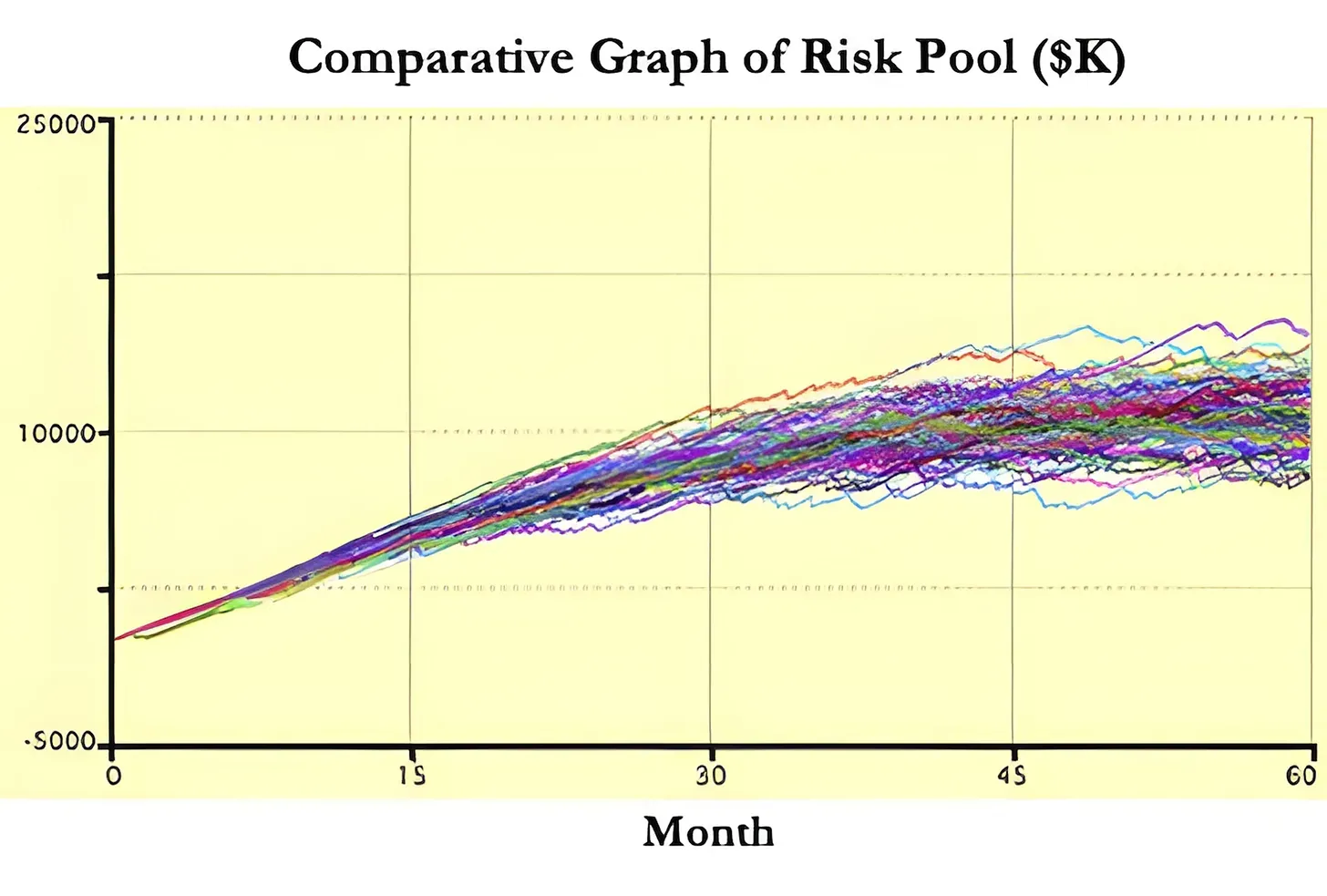
The simulation modeling revealed something surprising: the manufacturers' warranty pricing reflected a simplistic understanding of risk that ignored the system's natural resilience and self-regulating patterns.
When Understanding Meets Reality
The analysis indicated a clear opportunity, but the real test came in implementation. Within the first month, two imaging systems failed – a convergence of events that would have shaken less systemic thinking.
This moment perfectly illustrates the difference between surface knowledge and deep systemic understanding. The analytics team maintained their composure, recognizing these failures not as isolated disasters but as expected variations in a well-understood system. Their confidence came not from statistical calculations but from a fundamental understanding of how their system behaved.
Their confidence proved well-founded. By year's end, the company had captured over a million dollars in savings. These gains continued to accumulate as their understanding of the system deepened year after year.
Essential Insights
-
Build Understanding, Not Just Solutions:
The decision to develop in-house system dynamics capabilities created a foundation for ongoing insights and improvements. The team didn't just solve one problem – they developed the ability to understand and solve future challenges.
-
Trust Deep Understanding:
When early events seemed to challenge their strategy, their systemic understanding provided the confidence to maintain course. They knew the difference between systemic patterns and surface-level fluctuations.
-
Evolve with the System:
The team's commitment to continuous learning ensured their understanding evolved as their business system changed and grew.
-
Share the Vision:
Complex systemic insights became actionable through careful visualization and communication, enabling effective decision-making at all organizational levels.
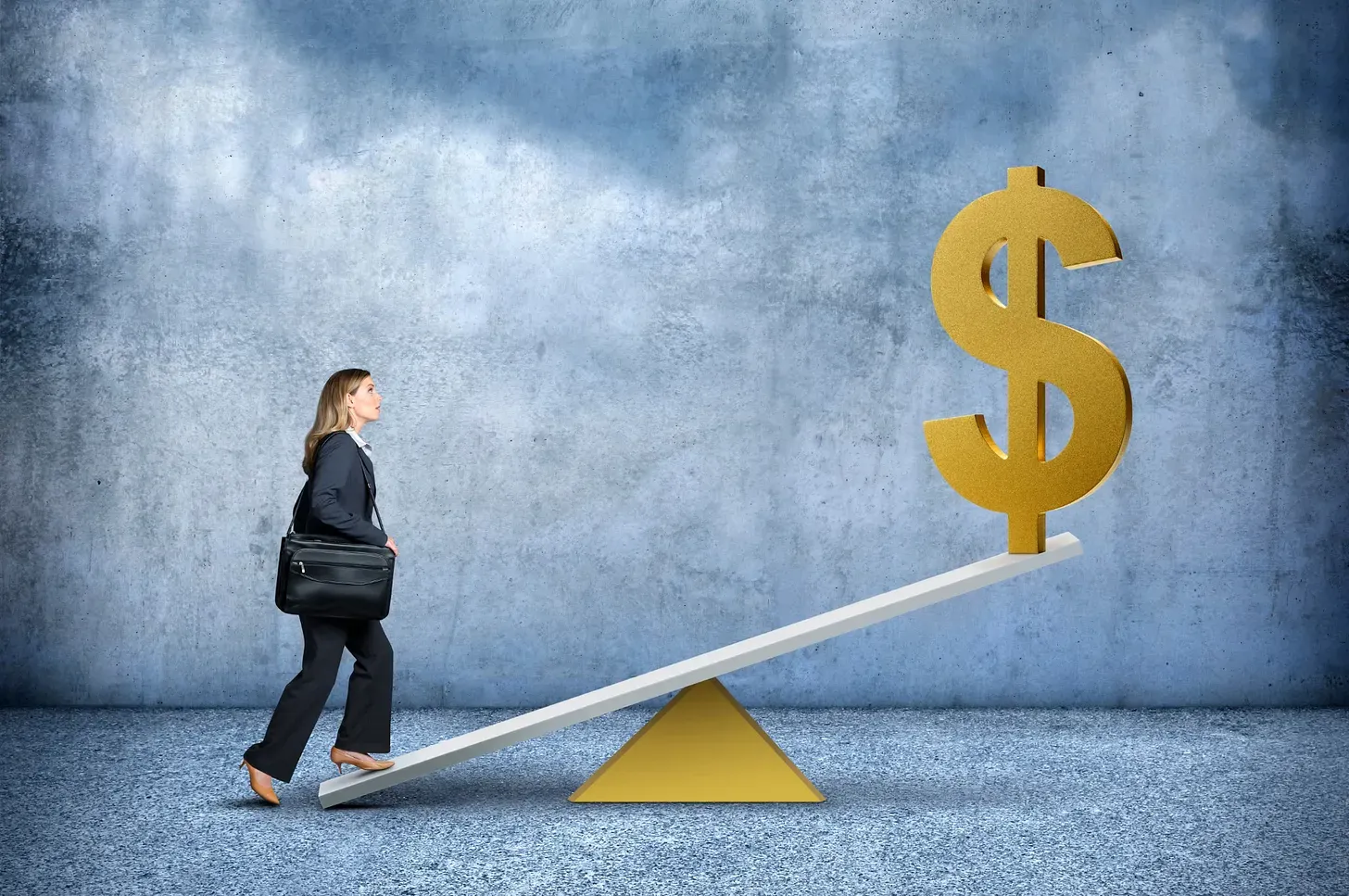
The Broader Perspective
This case transcends the immediate context of warranty cost reduction. It demonstrates how organizations can transform uncertainty from a source of anxiety into an opportunity for deeper understanding. System dynamics provides the framework for this transformation, enabling decisions based on genuine systemic intelligence rather than industry convention or surface-level analysis.
The million-dollar savings represent merely the quantifiable surface of a deeper change. The real achievement lies in developing an organization capable of seeing and understanding the complex systems that drive their business. This deeper vision reveals opportunities hidden from conventional analysis and builds confidence even in uncertain conditions.
This is the essence of high-leverage thinking in action – where systemic understanding, clear vision, and strategic insight converge to create lasting organizational value.
⇶ Inter-organizational
View all
⇶ Why Systemic Intelligence is Essential for Cross-Boundary Initiatives
"Attempting to foster systems change without building the capacity to 'see' systems leads to a lot of talk...and very little results." —Kania, Kramer and Senge
In today's interconnected world, most significant societal challenges span multiple boundaries - organizational, sectoral, geographical, and cultural. Whether we're addressing climate change, public health, economic inequality, or educational reform, success requires collaboration across traditional silos. Yet our conventional approaches to problem-solving often fall short when dealing with such complex, cross-boundary challenges. This is where Systemic Intelligence (SysQ) comes in; SysQ provides the ability to “see” systems — as Kania, Kramer and Senge assert — is essential to facilitate ecosystem transformation.1
THE CHALLENGE OF CROSS-BOUNDARY INITIATIVES
Adaptive leadership expert, Dean Williams, describes the challenge of working across silos.2
“Most people do not fully appreciate the systemic nature of their problems. We think and act parochially. The cultures of our respective groups and the respective roles we play in these groups often cause us to view problems through the narrow and myopic lens of immediate self- or group interest.”
—Dean Williams, Leadership For a Fractured World
Cross-boundary initiatives face several inherent challenges. Different organizations have their own goals, metrics, and ways of working. Supply chains involve multiple independent actors with competing interests. Public-private partnerships must bridge different organizational cultures and incentive structures. These differences often lead to unintended consequences, policy resistance, and failed initiatives.
Traditional linear thinking and simple cause-effect models prove inadequate because they fail to capture the complex reality of these situations. As we've seen, the real world is characterized by tight coupling between actors, feedback loops, nonlinear relationships, and adaptive behaviors. When we ignore these characteristics, our solutions often fail or even make problems worse.
COVID, SUPPLY CHAINS, AND INFLATION
The COVID-19 pandemic exposed critical vulnerabilities in global supply chains that a systemic intelligence approach could have helped anticipate and mitigate. When the pandemic hit, most organizations responded reactively - cutting production, reducing inventory, and laying off workers. These individual decisions, while seemingly rational from each organization's perspective, collectively amplified the system-wide disruption. A SysQ approach would have revealed how these local optimizations could create devastating ripple effects throughout the entire supply chain network.
By applying systemic intelligence principles, organizations could have better understood the crucial time delays and feedback loops in the system. For instance, the long delays in rebuilding production capacity and inventory levels meant that when demand suddenly returned, the system couldn't respond quickly enough, leading to shortages and inflation. SysQ tools like stock-and-flow mapping would have helped stakeholders visualize these delays and plan more resilient responses, such as maintaining strategic inventory buffers or investing in flexible production capacity.
Most importantly, systemic intelligence would have encouraged greater collaboration and information sharing across organizational boundaries. Instead of each company optimizing for its own survival, a systemic approach would have facilitated coordinated responses that considered the health of the entire supply chain ecosystem. This could have included joint investment in critical infrastructure, shared early warning systems, and collaborative capacity planning. The lesson from COVID-19 is clear: in our interconnected world, success requires not just organizational excellence but systemic intelligence to understand and manage complex inter-dependencies.
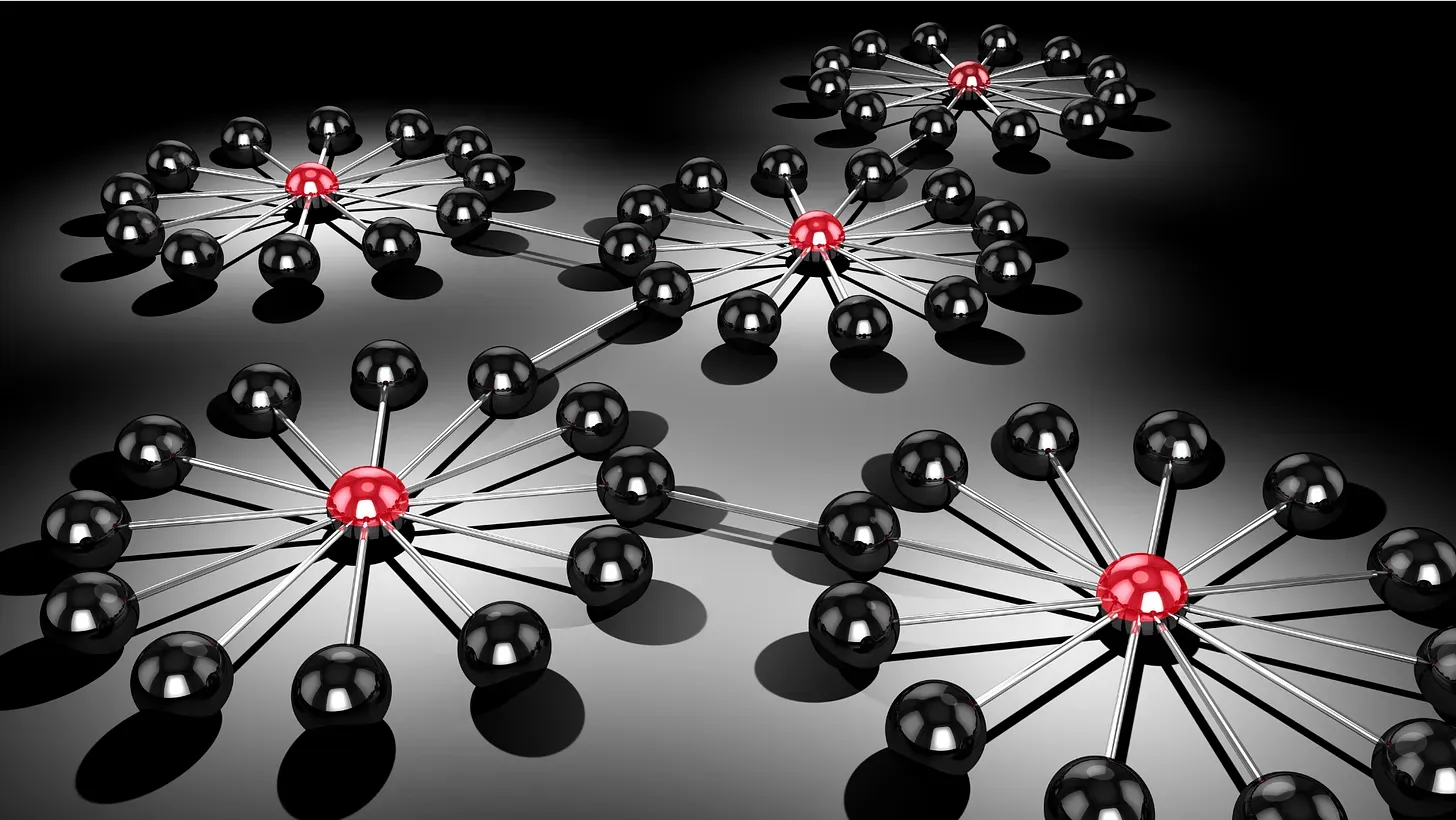
Systemic Intelligence provides both the mindset and tools needed to navigate cross-boundary challenges effectively. Using SysQ you will be better able to:
Uncover and see hidden connections
SysQ helps us map and understand the complex web of relationships and feedback loops that span organizational boundaries. This prevents us from missing critical interdependencies that could derail our initiatives.
Anticipate and prevent unintended consequences
By explicitly considering feedback loops and nonlinear relationships, SysQ helps us identify potential negative side effects before they occur, allowing us to design more robust solutions.
Promote shared understanding and implementation
SysQ tools like causal loop diagrams provide a common language for stakeholders from different backgrounds to discuss complex systems and build shared mental models.
It identifies high-leverage interventions: Instead of treating symptoms, SysQ helps us find the root causes and points of leverage that can create lasting positive change across the entire system.
PRACTICAL APPLICATIONS
Consider these examples where Systemic Intelligence is crucial:
Supply Chain Transformation
SysQ reveals how changes in one part of the supply chain affect other participants, helping design win-win solutions that benefit the entire network.
Public-Private Partnerships
By mapping the different incentives and feedback loops affecting each partner, SysQ helps design more effective collaboration mechanisms.
Collective Impact Initiatives
When multiple organizations work together on complex social issues, SysQ helps them understand how their different programs and interventions interact and influence each other.
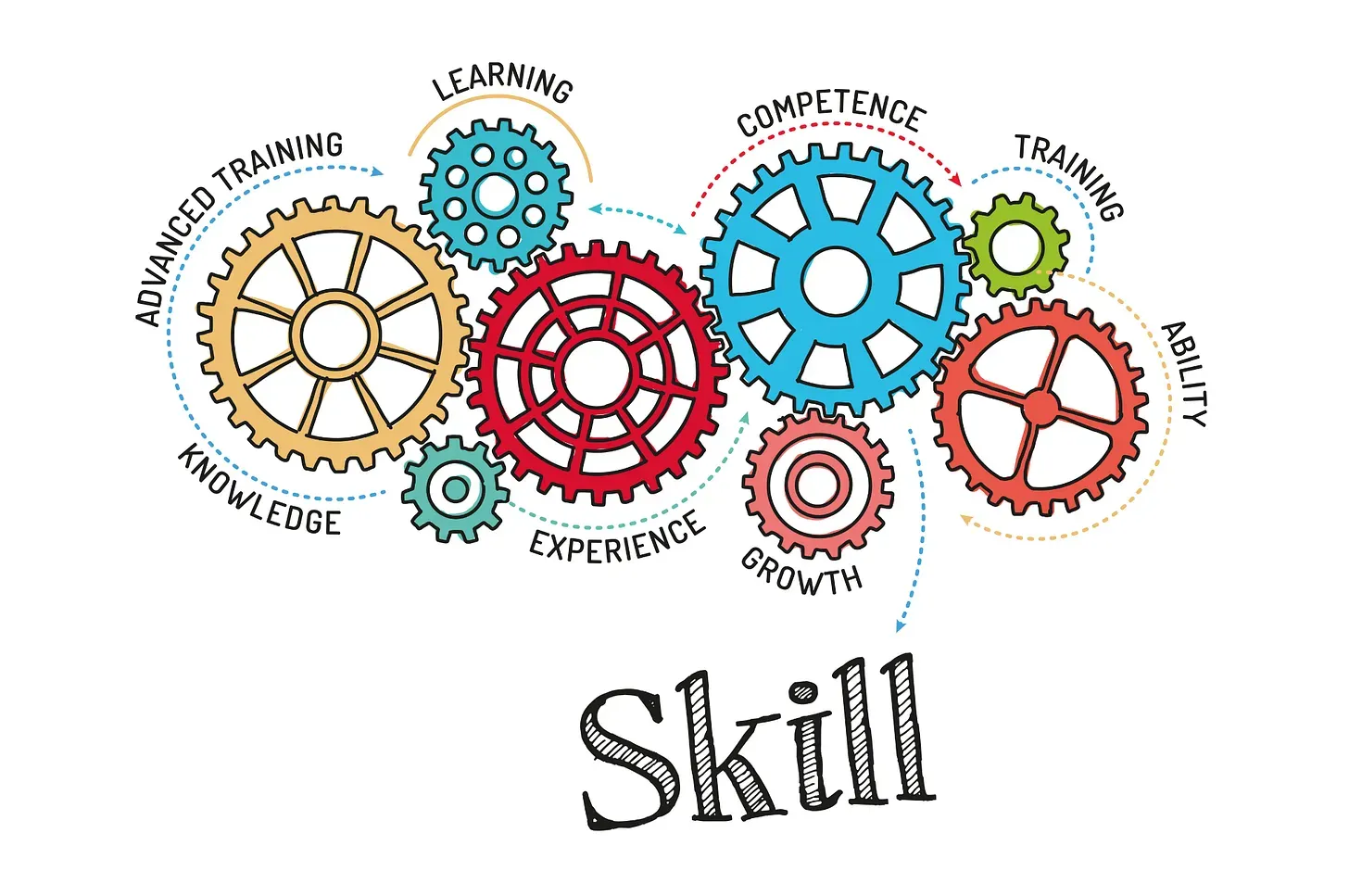
BUILDING SYSTEMIC INTELLIGENCE CAPACITY
To succeed in cross-boundary initiatives, organizations and leaders need to develop their Systemic Intelligence capacity. This involves:
-
Learning to identify and map feedback loops and system structures
-
Developing comfort with complexity and nonlinear thinking
-
Using tools that capture both "hard" and "soft" variables
-
Building shared understanding across organizational boundaries
As our world becomes increasingly interconnected, the ability to think and act systemically across boundaries becomes not just valuable but essential. Organizations and leaders who develop strong Systemic Intelligence will be better equipped to tackle complex challenges and create lasting positive change.
Without this capacity, we risk continuing to implement solutions that fail to address root causes, generate unintended consequences, and waste precious resources. With it, we can design more effective interventions that create positive change across entire systems.
INTER-ORGANIZATIONAL AREA
Because the world is rapidly complexifying, we need to collaborate across boundaries to address the knotted, interdependent problems we face. During COVID we were hoarding toilet paper from global supply chain disruptions. The lingering effects of this interdependent ecosystem continued for several years in the form of higher than normal inflation.
NGOs are finding they need to work in coalitions — often gravitating to collective impact processes — in order to address interconnected problems of well-being like health, housing, poverty, and racism.
Content with the Inter-Organizational tag will describe how SysQ helps orchestrate learning across boundaries. You’ll see how it helps improve working relationships with suppliers, contractors, and partner organizations. You’ll learn about how coalitions and collaboratives use SysQ to find greater leverage on important Societal issues.
1
Kania, Kramer, and Senge, The Water of Systems Change, FSG, 2018 https://www.fsg.org/resource/water_of_systems_change/
2
Williams, Dean. Leadership for a Fractured World: How to Cross Boundaries, Build Bridges, and Lead Change, Berrett-Koehler, 2015.

Breaking Down Silos: How Systemic Intelligence Transformed Children's Behavioral Health in Georgia
"Alone we can do so little; together we can do so much." —Helen Keller
Picture a room full of dedicated professionals, each representing different aspects of children's behavioral health services in Georgia. They've been meeting for over a year, all sharing a common goal of helping children, yet finding themselves stuck in a cycle of unproductive discussions and competing interests. This is the story of how developing systemic intelligence transformed their approach and unlocked collaborative potential that had remained dormant for far too long.
The Strategic Challenge
The state's interagency directors' team (IDT) faced a daunting task: fundamentally transform how various agencies coordinated services to improve children's behavioral health. The team included representatives from developmental disabilities, community health, education, juvenile justice, and other critical services. Their mission seemed clear – break down organizational silos and develop an integrated strategy for improving children's behavioral health.
But clarity of mission doesn't always translate to clarity of action. Despite regular meetings and genuine commitment from all parties, progress remained elusive. The system itself seemed designed to resist the very collaboration they sought to create.
Building Intelligence About Complex Systems
The Georgia Health Policy Center, working with Pontifex Consulting, recognized that before the team could transform the system, they needed to transform how they understood it. They began by building the team's capacity for systemic intelligence – not as an academic exercise, but as a practical tool for seeing their challenges in a new light.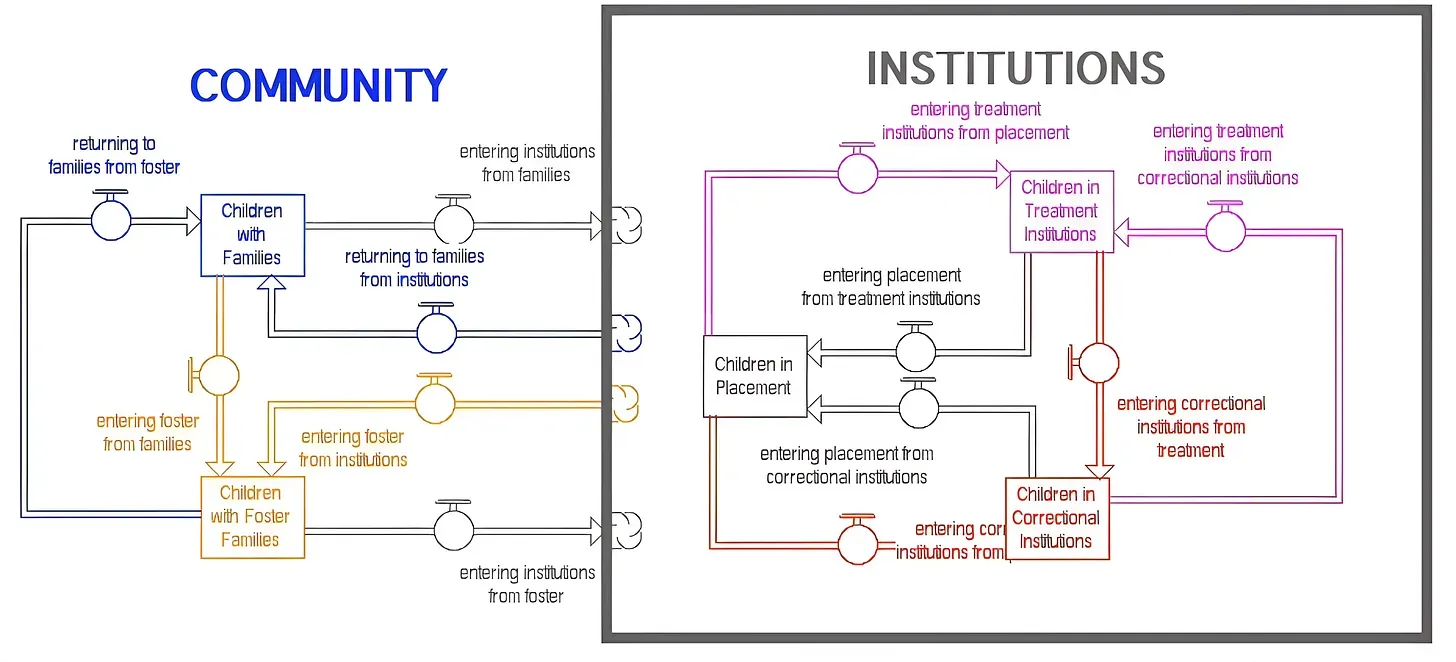
The first revelation came through mapping the current state. The initial diagram revealed a service-centric "push" system where organizations competed to provide their specific services to qualified children and families. In this model, children were often shuffled between services, with little improvement in their long-term development trajectory. The main accomplishment was often simply transferring responsibility from one agency to another.
Seeing the Whole System
Through the process of building and discussing system maps, something remarkable happened. The team began to shift their perspective from individual service providers to seeing the entire developmental journey of the children they served. They created a "Managed Population Chain" that traced a child's path from prenatal care through to adulthood.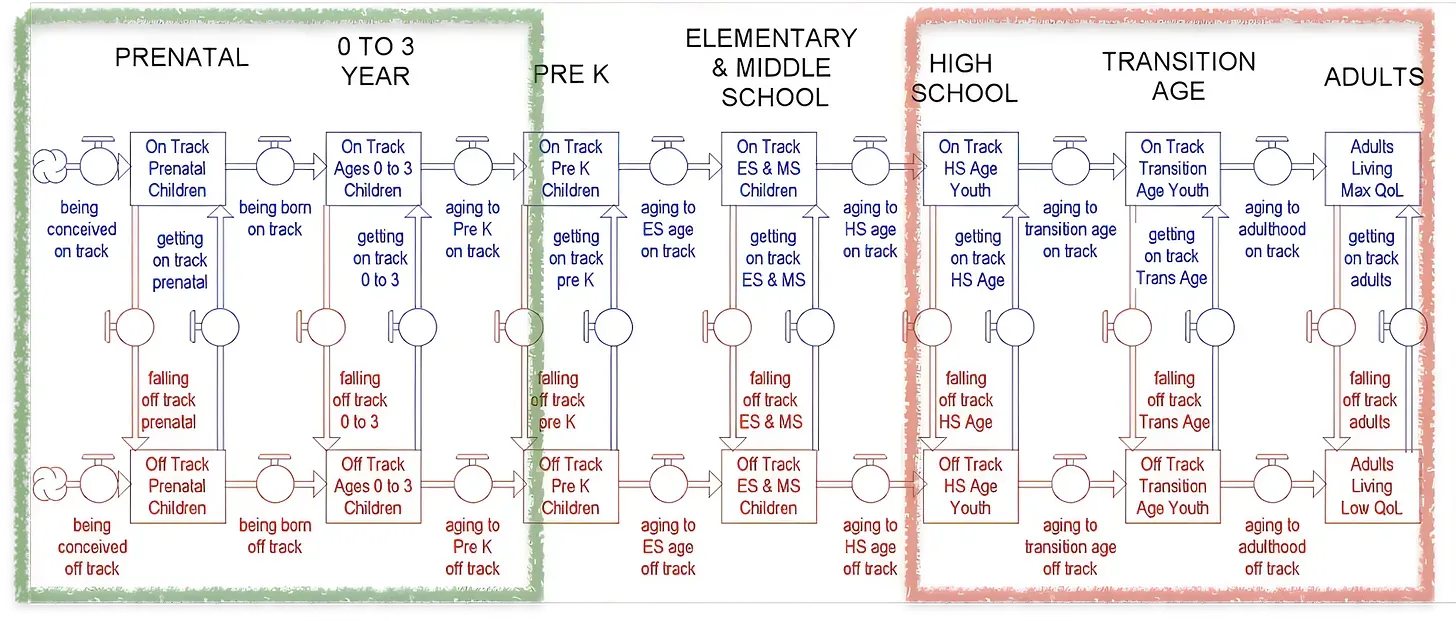
A profound insight emerged: The further along this chain a child moved while "off track," the more costly and urgent the interventions became. Yet the system provided little incentive for upstream collaboration – leading agencies to compete for resources at "the end of the line" where problems were most severe and expensive to address.

The Power of Shared Vision
The breakthrough came when the team developed their final simplified strategy map. This visual tool accomplished something that a year of meetings couldn't – it gave them a shared language and framework for understanding both problems and solutions. As one team leader noted, "Now I see how we can focus on a child at each stage of their development and think about what they need...and how we can each coordinate our resources to fulfilling that need."
This wasn't just a map – it became the foundation of their strategy, a communication tool for engaging with state health commissioners and other officials, and a dynamic framework that could evolve with their understanding.

Core Elements of Change Agent Leadership
In his book Leadership for a Fractured World, Dean Williams describes essential principles employed by effective change agents. The interagency team applied several of these principles during their strategy work. Three of those key principles were:
Facing Reality Together:
Rather than avoiding difficult truths or seeking quick fixes, the team learned to collectively face the reality of their fragmented system. They developed what Williams calls "diagnostic capacity" – the ability to understand complex challenges from multiple perspectives.
Boundary Crossing:
The team embodied the change agent's role as a boundary crosser, moving beyond their organizational silos to engage with other perspectives and possibilities. This wasn't just about coordination – it was about creating new spaces for collaboration and innovation.
Harnessing Creative Tension:
Like artists working with different materials and techniques, the team learned to work with the creative tension that emerges when diverse perspectives meet. They discovered that progress often requires maintaining this productive tension rather than rushing to eliminate it.
The Three Transformations
The development of systemic intelligence catalyzed three fundamental shifts in the team's approach:
Reframing the Goal: They moved from a supply-side focus on providing services to a demand-side vision of developing self-actualized adults. This shift opened up entirely new solution spaces that weren't visible before.
Developing Shared Understanding:
The team moved from "close-to-the-chest, keep our interests guarded" perspectives to a comprehensive, 30,000-foot view where they could see and appreciate the whole system.Unleashing Collaboration:
Most profoundly, they transformed from a group of individual stakeholders into a cohesive team with a compelling way forward. They shifted from pointing fingers at each other to pointing at their shared map – working together to make it better
The Broader Perspective
This case demonstrates how systemic intelligence can break through seemingly intractable inter-organizational challenges. The team didn't just solve a specific problem – they developed a new way of seeing and thinking about their work. They created a sustainable foundation for ongoing collaboration and improvement.
The success was so compelling that the team subsequently applied the same process to develop a strategy for "at risk" children, demonstrating how building systemic intelligence creates ongoing capacity for tackling complex challenges.
This transformation shows that when organizations invest in building their capacity for systemic intelligence, they don't just solve immediate problems – they develop the ability to see, understand, and improve complex systems continuously. This is the essence of high-leverage thinking in action.
🌐 Societal
View all
🌐 Building Systemic Intelligence: A Critical Capacity to Understand Today's Complex Challenges
"Anyone who aspires to make observations about mankind should look upon the human scene as from some lofty height." — Marcus Aurelius
The recent global supply chain disruptions provide a perfect illustration of why we need systemic intelligence to address today's interconnected challenges. When COVID-19 hit, organizations responded individually - cutting production, reducing inventory, and laying off workers. While these decisions made sense from each organization's perspective, they collectively amplified system-wide disruption, leading to shortages and inflation that we're still grappling with today.
“The world is a complex, interconnected, finite, ecological-social-psychological-economic system. We treat it as if it were not, as if it were divisible, separable, simple, and infinite. Our persistent, intractable global problems arise directly from this mismatch.”
—Donella Meadows
This is where systemic intelligence (SysQ) becomes essential. Rather than viewing problems in isolation, SysQ provides tools and frameworks to understand how different parts of a system interact across organizational boundaries. It helps us see the deeper structures driving complex problems, revealing crucial time delays and feedback loops that traditional analysis often misses.
THE EXTRA VALUE OF SYSTEMIC INTELLIGENCE
Systemic intelligence adds three critical dimensions to problem-solving and strategy creation:
Shared Understanding —
SysQ provides a common language and visualization tools (like stock-and-flow mapping) that help diverse stakeholders build shared mental models of complex systems. This shared understanding is crucial for effective collaboration across organizational boundaries.
Long-term Perspective —
By making time delays and feedback loops visible, SysQ helps organizations move beyond quick fixes to develop solutions that address root causes and consider long-term implications.
Collaborative Solutions —
Instead of optimizing individual parts, SysQ encourages stakeholders to consider the health of the entire system, leading to more effective collaborative responses to complex challenges.

BUILDING SYSTEMIC INTELLIGENCE CAPACITY
For NGOs and communities looking to develop systemic intelligence, I recommend starting with these key practices:
Build Shared Maps —
Create visual representations of the system you're trying to understand. Focus on identifying key resources, flows, and feedback loops that generate current outcomes.
Focus on Physics —
Pay attention to the actual resources and constraints in your system - what I call the "physics." This helps ground discussions in reality rather than assumptions.Look for Time Delays —
Identify where significant delays exist between actions and their effects. This understanding is crucial for developing realistic implementation timelines and managing expectations.
Foster Cross-boundary Dialogue —
Create regular opportunities for stakeholders from different parts of the system to share perspectives and develop shared understanding.
MAKING SENSE OF SOCIETAL ISSUES
Through my upcoming Substack series, I'll be helping readers develop their systemic intelligence capacity by exploring real-world examples and providing practical tools for understanding complex societal issues. We'll examine cases like the supply chain disruptions, showing how systemic thinking reveals deeper patterns and more effective intervention points.
Each article will combine accessible explanations of systemic principles with practical applications to current challenges. My goal is to build a community of practitioners who can apply these tools to create more effective, sustainable solutions to our most pressing societal issues.
In today's interconnected world, success requires more than just organizational excellence - it demands systemic intelligence to understand and manage complex interdependencies. I invite you to join me on this journey of building this essential capacity together.
NAVIGATING TODAY'S COMPLEX NEWS LANDSCAPE
In an era of information overload, systemic intelligence offers valuable tools for making sense of today's rapid-fire news cycle. Rather than viewing each headline in isolation, SysQ helps us understand how different events and trends interconnect and influence each other.
For example, when analyzing current geopolitical tensions, systemic thinking reveals how economic policies, resource constraints, and social dynamics create reinforcing feedback loops that can either escalate or de-escalate conflicts. This deeper understanding helps us move beyond simplistic narratives to grasp the full complexity of global events.
Pattern Recognition —
SysQ helps identify recurring patterns in seemingly unrelated events, revealing deeper systemic structures that drive similar outcomes across different contexts.
Multiple Perspectives —
By encouraging us to consider various stakeholders' viewpoints, SysQ provides a more nuanced understanding of complex social and political issues.
Future Implications —
Understanding systemic connections helps us better anticipate potential long-term consequences of current events and policy decisions.

THE CASE FOR SYSQ JOURNALISM — WHY WE NEED A NEW APPROACH TO COVERING THE “NEWS”
The increasingly complexifying, interconnected world is inscrutable to typical approaches to news gathering, analyzing and sharing — even in those rare cases where the news is analyzed. We need an approach that moves from merely reporting the news into a systemic sense-making approach that generates insight. In short, we need to surface above the ocean of news “events”, moving from data to information to insight.
SysQ Journalism, if implemented, would be a powerful way of reporting that goes beyond just telling isolated stories. Instead, SysQ Journalism would show how different issues are connected. The main goal is to reveal the systems and structures behind the challenges we face, helping people who want to make a difference understand the bigger picture. By using a systemic intelligence approach, this type of journalism will help communities understand the root causes of problems, which can lead to better solutions. It will create more informed and engaged citizens that can solve community challenges and ultimately the urgent global issues we face. SysQ Journalism, because it is based on systemic intelligence promotes the tackling issues with a connected and holistic view.
The need for systems journalism is urgent because the world is facing many interconnected challenges, and it’s crucial to equip and empower people who can drive change. Traditional journalism often doesn’t capture the complexity of these issues, which can lead to misunderstandings and ineffective responses. Systems journalism, on the other hand, provides a complete picture and emphasizes teamwork, problem-solving, and adaptability. By giving people the tools and knowledge they need, it helps break down barriers and encourages innovative solutions, promoting essential skills for those working to bring about global change.
The importance of systems journalism is further highlighted by the Great Unraveling of the global polycrisis, which describes the breakdown of global systems due to multiple crises.1 To address these problems, it’s important to improve the skills of leaders and influencers so they can use a systemic approach in their decisions. Systems journalism is crucial in this effort as it sparks learning and change. It shows how global issues are connected, encouraging a broader way of thinking necessary to tackle the complex problems of our time and helping to create a more informed and involved society.
GLOBAL DYNAMICS — USING SYSTEMS JOURNALISM TO MAKE SENSE IN TURBULENT TIMES
In 2023, in an effort to promote systems journalism and make sense of global issues, I produced a video called Global Dynamics — Making Sense in Turbulent Times. The video includes an ecosystem map showing the interconnections between several global phenomena, including:
-
Rising authoritariansim
-
Polarization and extremism
-
Dark money influence on politics
-
Corruption
-
Cryptocurrency
-
Social media influence
-
Climate change

I will create several future posts describing the issues in the global ecosystem map — as individual and interconnected issues — to the Societal Applications section. Understanding these interconnections could help identify the levers needed to avert future crises or mitigate current and future ones.
You can watch the video here.
SUMMARY
As we face increasingly complex global challenges — from climate change to technological disruption — systemic intelligence becomes not just useful, but essential. It provides the cognitive tools we need to navigate uncertainty and work toward more effective, sustainable solutions. Systems Journalism is the vehicle for building our SysQ and insight regarding important global dynamics. We need this insight and capacity to navigate the turbulent waters of today…and tomorrow.
1 Heinberg, R. and Miller, A., Welcome to the Great Unraveling: Navigating the Polycrisis of Environmental and Social Breakdown, Post Carbon Institute, 2023
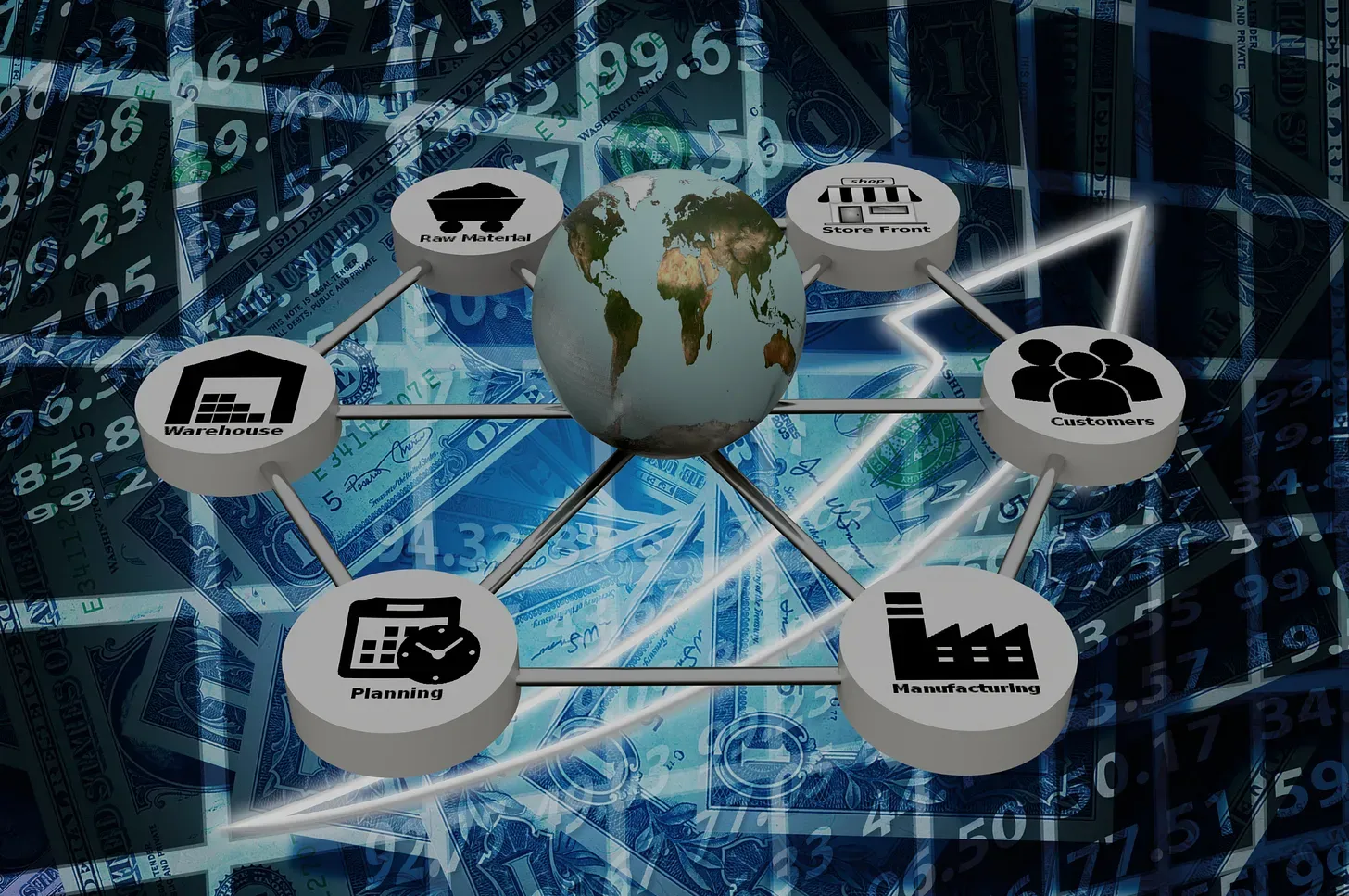
🌐 Inflation Fears Rise. Paper Supply Falls.
Building better understanding of global supply chain woes...and subsequent inflation.
Author’s note (2021)
The following was written prior to news about issues with the transportation system making it harder to get goods across the international economy. These delays only exacerbate the delays in the analysis below, making the impacts of the time delays described here even worse. This is what we’re experiencing.
Author’s note (2025)
Since this article was written, the world experienced long term inflation — as expected. The US managed to bring inflation under control faster. The analysis still holds regarding structural causes of supply / demand imbalances and inflation.
NY Times Headline: The World Is Still Short of Everything. Get Used to It.
US News Headline: Delta, Inflation Fears Push Consumer Sentiment Down Sharply in August
If you tune in to the Sunday morning economic pundits you’ll hear differing opinions about inflation. It’s here. It’s coming. It’s the current President’s fault. No, it’s the previous President’s. What’s going on?
Meanwhile…
A writer friend of mine—excited to be publishing their third book—lamented the other day, “I never thought I’d try to sell a new book in a time when printing paper was hard to find.” You’d think in a digital age there would be plenty of paper. Why the paper shortage? (Just today, Costco announced a purchase limit for toilet paper similar to 2020’s.)
Perhaps most important of all: How might these seemingly disparate issues be related?
SYSQ CAN ILLUMINATE
Systemic Intelligence (SysQTM) is the capacity to frame and analyze issues in ways that can generate maximum insight—which is the only way to identify optimal solutions. One of the core principles of SysQ is to Build a Shared Map of the territory of interest—a picture of the systemic structure driving the system’s performance. Another principle is to Focus on the Physics—make sure the map’s proposed causal connections are consistent with reality.
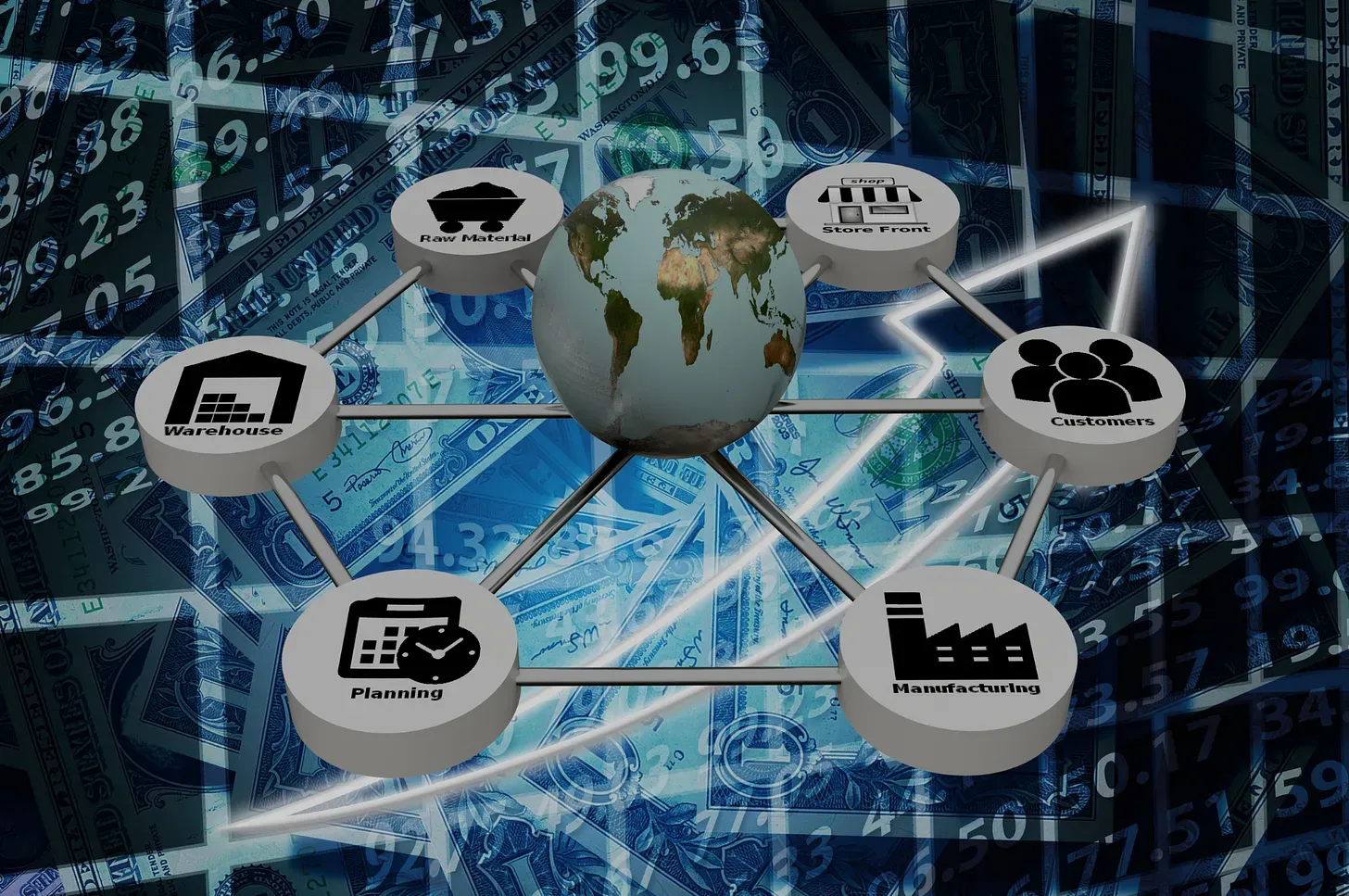
THE BASICS OF SUPPLY AND PRODUCTION
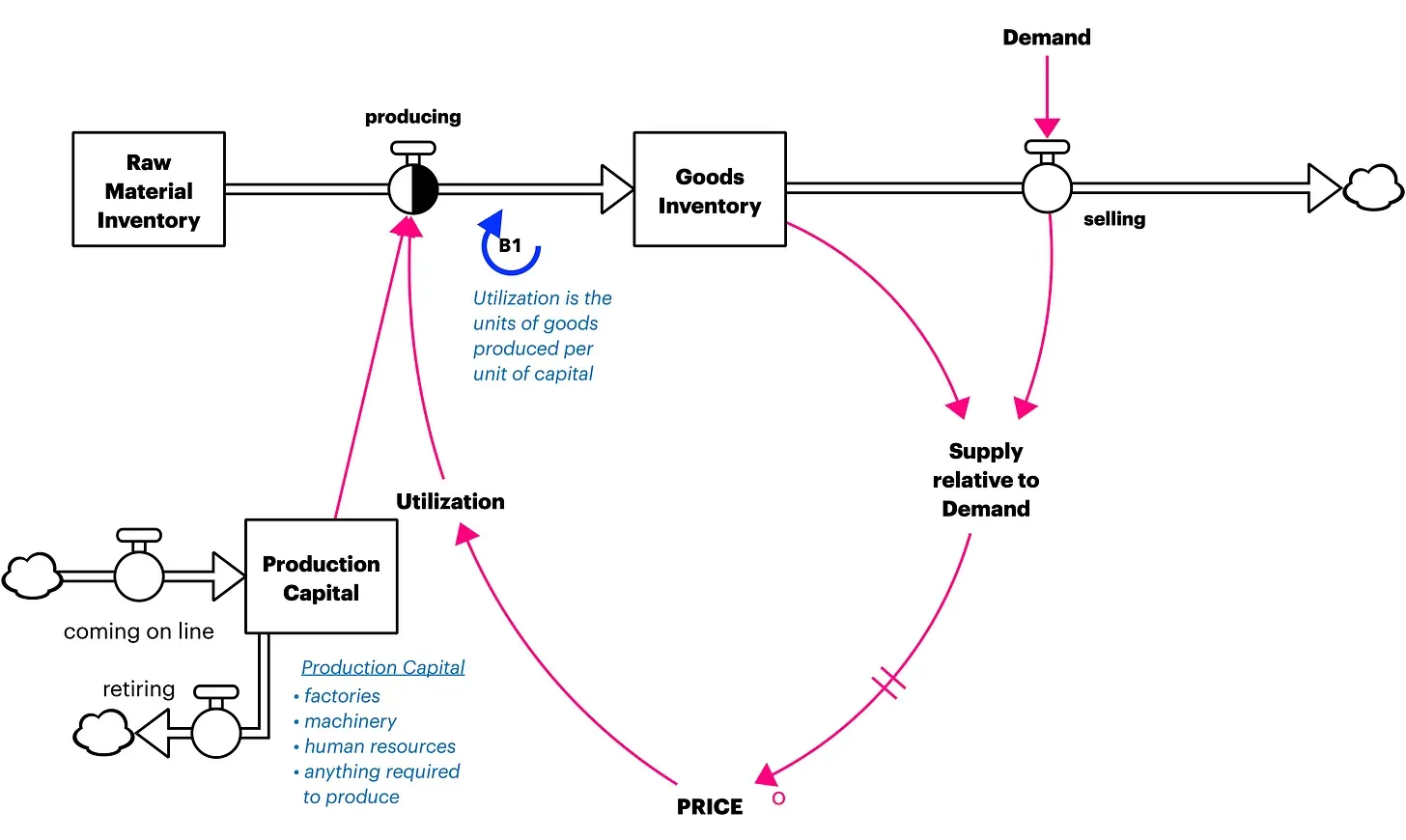
A 30,000 meter view of any industry might look like the map above. At any point in time, you can count up the current amount of goods in the Goods Inventory stock. The stock is like a bathtub. It accumulates inventory.
What fills it up each week is the amount of producing (production) that week. This inflow of producing is like the spigot into a bathtub. The valve (on top) determines how fast or slow the bathtub of Goods Inventory fills. On the outflow, Consumer Demand determines how much selling (inventory sold per week) occurs weekly. If Demand increases, the rate of selling goes up. Lower Demand reduces the rate of selling.
Bathtub physics dictate that Goods Inventory goes up anytime the rate of producing exceeds the rate of selling. The only time Goods Inventory decreases is when selling exceeds producing.
The B1 indicates a balancing loop. Balancing Loops try to maintain equilibrium. If Goods Inventory declines, Price rises, utilization increases, Goods Inventory bounces back…and Price decreases again.
INCREASING THE CAPITAL STOCK INCREASES PRODUCTION
Producing occurs from applying Production Capital. Production Capital is also a stock, because you can stop time and in that moment count up the total amount of capital available. The rate of producing (units of goods produced / week) is determined by Production Capital * utilization (units of goods produced / unit of capital / week). To produce more requires increasing either the amount of Production Capital or its utilization (productivity) of capital—or both.
The binary shading of the producing flow indicates that there’s not a 1:1 conversion of raw material units into units of goods. One computer (a good) requires thousands of parts (raw materials like chips, boards, wires, etc…).
When Goods Inventory is running low, and especially when Price is high and industry profitable, organizations will order more raw materials, increase utilization and/or invest in new capital.
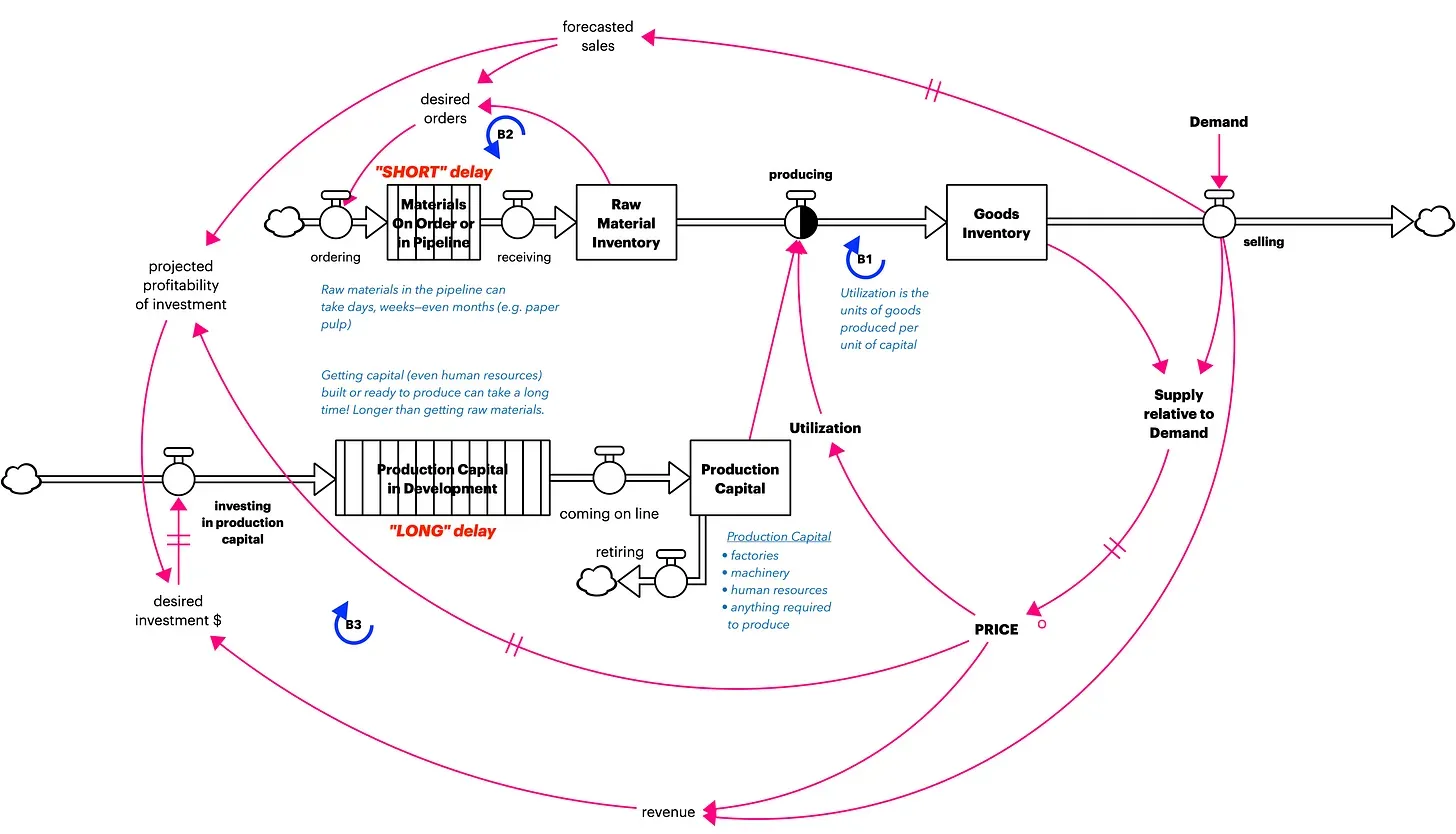
NOTE: It’s often easier—and takes significantly less time—to increase productivity (aka utilization) than to add Production Capital. Adding capital usually requires a flow (activity) of investment in production capital. That capital then steps onto a development conveyor and doesn’t actually become available to produce for a while. Sometimes this time delay takes months.
SUPPLY RELATIVE TO DEMAND—>PRICE
If Demand increases, the rate of selling increases, drawing down Goods Inventory. The Supply relative to Demand falls; Price will increase.
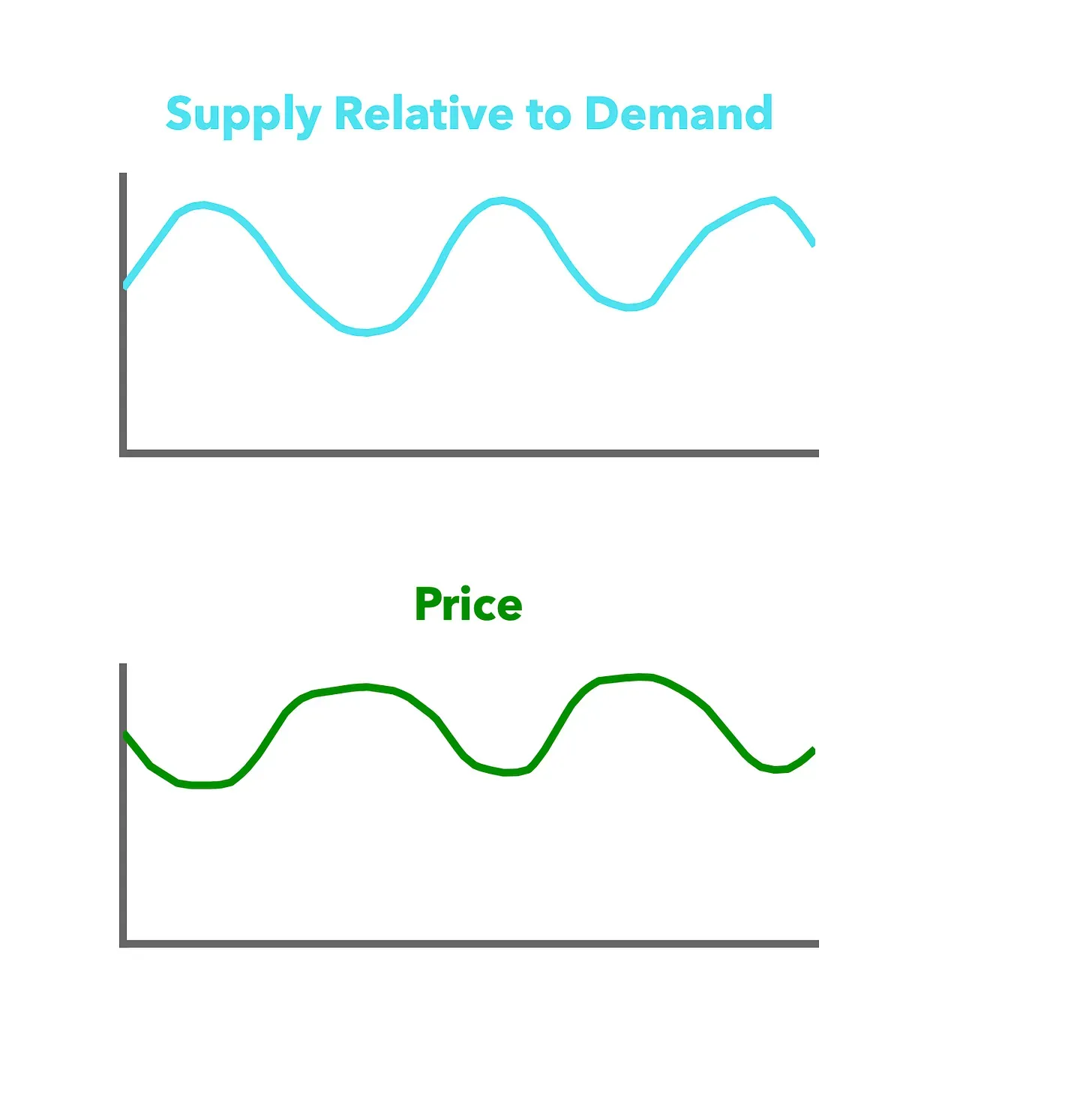
A producer typically responds by increasing utilization (units of goods produced per unit of capital) in order to produce more, filling up Goods Inventory, and bringing supply and demand back into balance. Price usually stabilizes to previous levels. Sometimes, producers will invest in new capital to increase production. This requires a much longer time horizon in order to implement.
**WHY INFLATION? WHY SUPPLY SHORTAGES? AT THE SAME TIME?**
Under most situations, these balancing loops work to regulate the market so that production, inventories, and price oscillates around equilibriums—often with a little annual growth to create an upward sloping curve.
A Sustained Shock
But what happens occasionally are sustained shocks to a system. For example, if there’s a broad and sustained shock to demand (e.g. a lockdown), the following might occur.
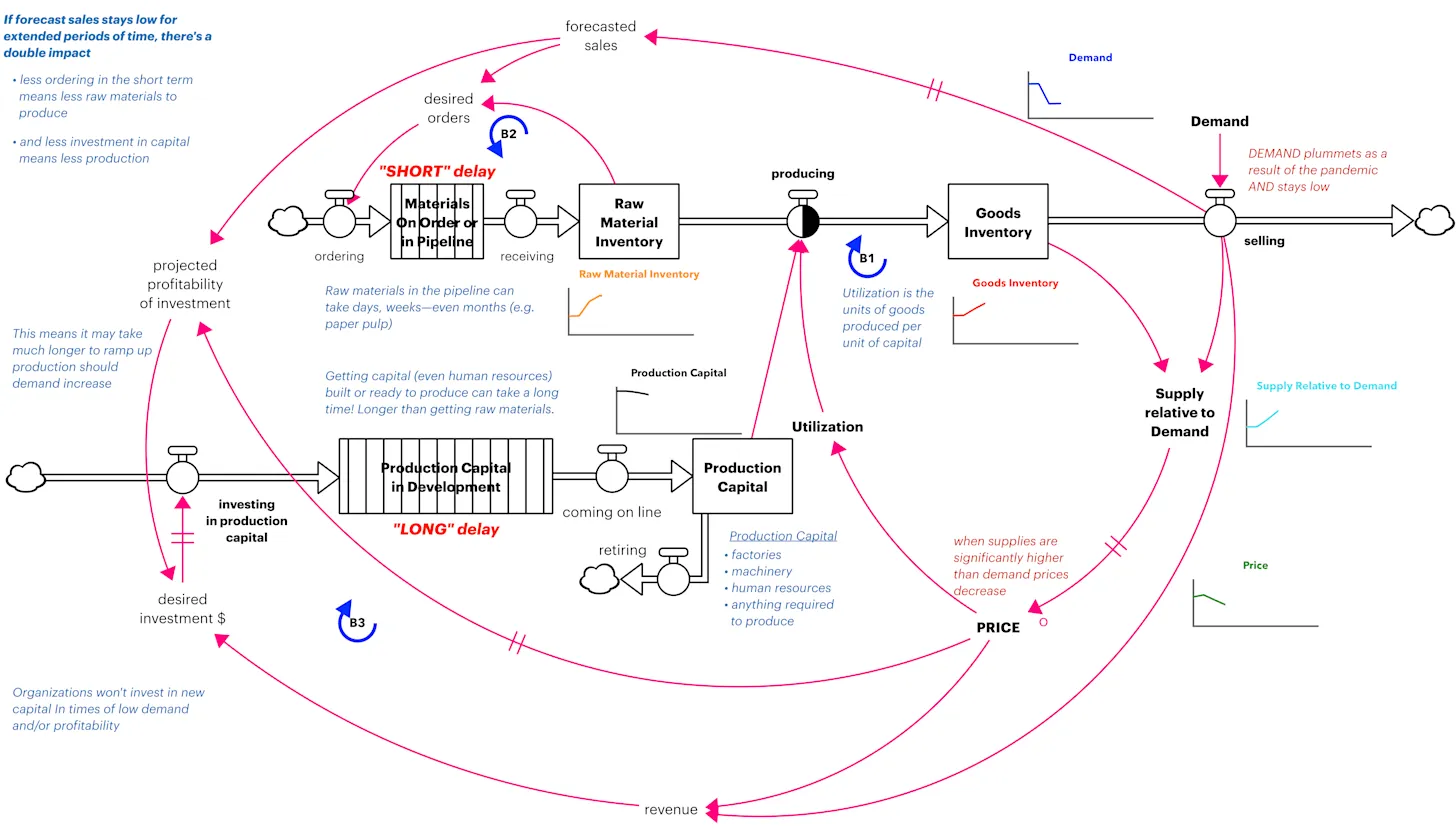
Demand (blue trend) plummets and stays low. Supply relative to Demand begins to creep up (as unsold inventories increase). Too much supply causes Price to drop (or at least not increase anymore).
All of these reduce short-term utilization and materials ordering. This means less harvesting of trees, less of simple materials that are components to chips and computers, less of the basics. There will be less Raw Material Inventory (orange trend)
Further, Production Capital naturally retires, so the stock diminishes (or certainly doesn’t grow).
Demand Returns, But System Remains Behind
If Demand suddenly returns, the system can’t adjust back to normal immediately. Because Goods Inventory is now insufficient for this increased Demand, Supply relative to Demand decreases, and Price increases.

Utilization, ordering, and investing in production capital increases. But due to the long time delays—some delays are substantial—Price continues to rise as Supply relative to Demand remains low.
And INFLATION!
Inflation Continues
Inflation (increasing Price above wage increases) will continue for a long time as the system tries to recover…especially if Demand continues to remain high. The long pipeline delays ensure this dampening of inflation takes time.
Solutions?
What will address this shortage combined with inflation? The main national lever works on demand. The strongest lever is the natural one: Price—>Demand. Yes. Prices will eventually go high enough to naturally suppress demand. As selling slows, inventories can catch up, and Price will fall (or stop rising as fast).
Policies that could slow demand sooner might include short term taxes on some (perhaps luxury) items that require a lot of raw materials. This would increase actual Price faster than inflation and put the brakes faster. Plus, luxury items taxes wouldn’t negatively impact those suffering the most. And if the tax was reinvented in ways that increase the development of supporting infrastructure and capital, then the system would rebound faster.
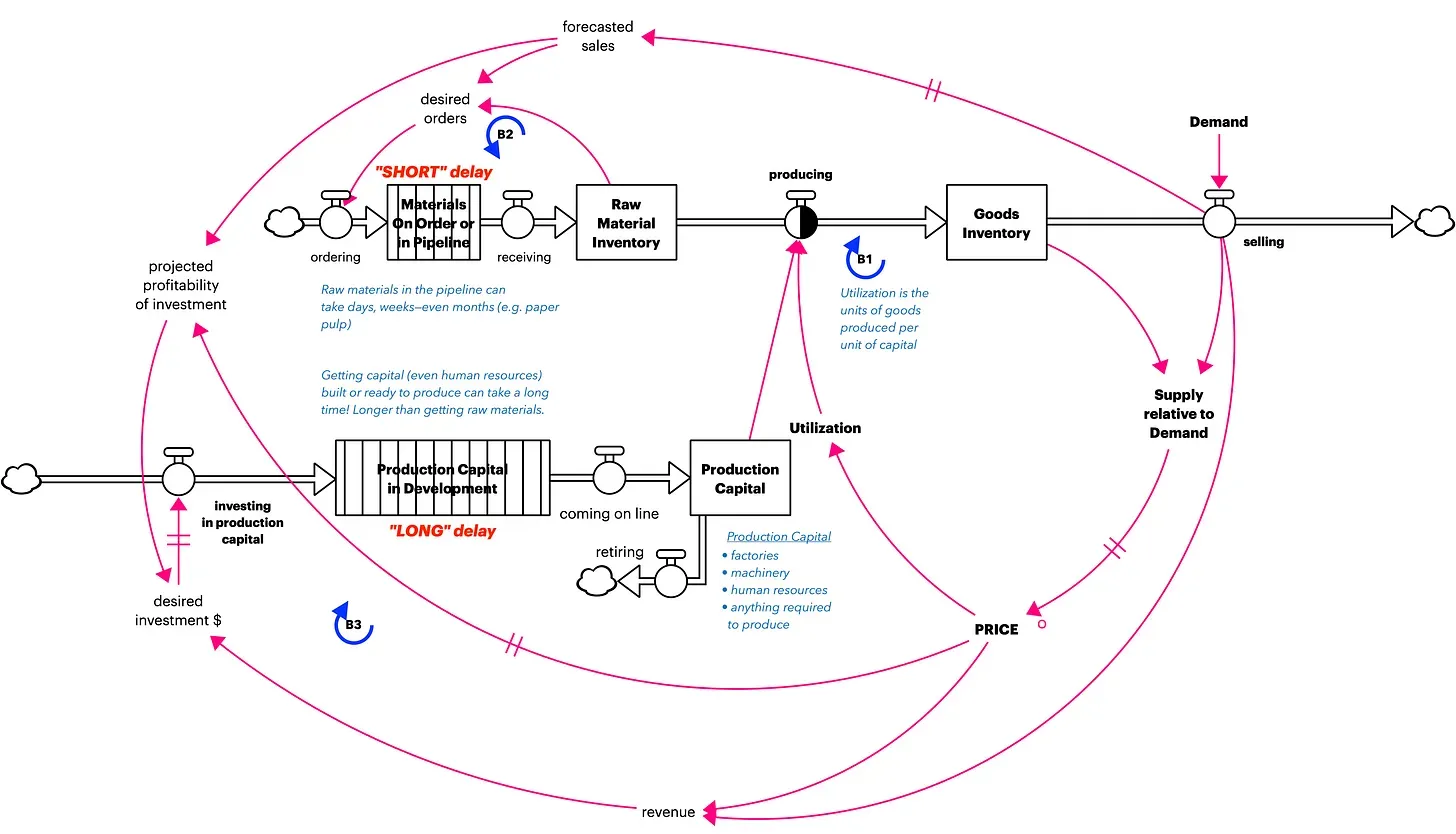
Additionally, there could be incentives to industries to invest in capital even when their forecasts don’t encourage them to do so. Incentives to add supporting infrastructure or invest in employee development would pay off in the medium to short term.

IMPLICATIONS
What happened in 2020 was unique in that Demand was suppressed suddenly (lockdowns) and for a longer time than typically. This means that rising inflation now is absolutely to be expected. So, who’s to blame?
The current President wasn’t responsible for the 2020 sudden and sustained decrease in Demand. And the previous President, although a different way of handling the pandemic might have reduced the impact on Demand, isn’t responsible for the way the market is now responding to reinvestment to bring production back up to previous levels.
Key Insight
Today’s macroeconomic performance is rarely the result of decisions made within the past few months. Using a longer term mental model of the structure generating performance will increase our ability to assess any attributions of “who’s to blame?”
🌱 Personal
View all
Ripple Across Time Awareness
All actions leave traces — make yours have broader, longer-term impact
I had just arrived at my high school band reunion. It had been over 33 years since I had graduated high school and I was reconnecting with friends at a new bar that had just opened on Main Street. I hadn’t seen nearly 100 of my musical brothers and sisters since the days when our high school bands—marching, concert and jazz—ranked consistently among the best of the best in Illinois. We were the Marching Streaks, hailing from Galesburg, Illinois—a downstate farm town of 33,000 (and shrinking). We had to compete against Chicago schools that were often four times our size in population, and significantly better funded.
As we sipped our beer, my friends from the trombone section and I began the weekend of celebration. We were there to celebrate the impact of our always beloved (and sometimes feared) band director. She had shaped the lives of thousands of my peers over her fifteen years as the high school band director, and grand Pooh Bah of the musical ecosystem for Galesburg.
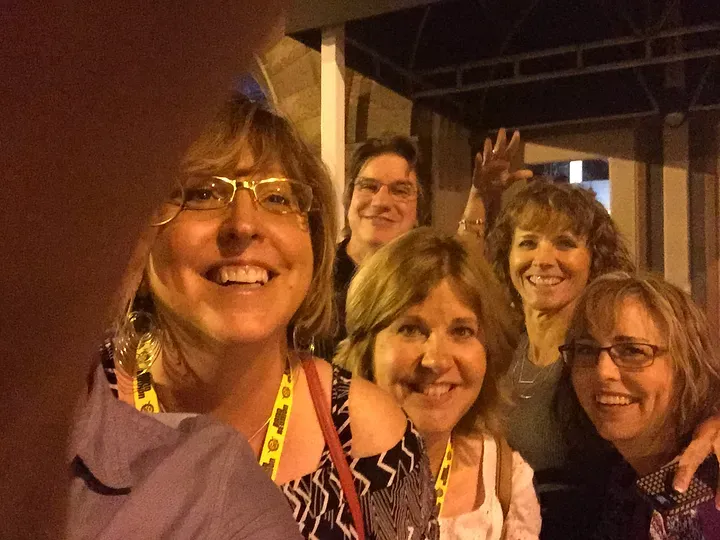
 I had just received my beer when my smartphone buzzed. I looked down at the message. It was from Karen, a former girlfriend from almost as far in the past as my band days. It had been over 20 years since I’d seen her.
I had just received my beer when my smartphone buzzed. I looked down at the message. It was from Karen, a former girlfriend from almost as far in the past as my band days. It had been over 20 years since I’d seen her.
“You need to watch this video,” the message said. I looked. There was a young girl, perhaps 12 years old who appeared to be at a recital, sitting with a guitar in front of an audience of obviously family members…hers and those for other young music students.
I had more pressing concerns. I closed my phone and returned to reconnecting with old friends.
We spent the weekend recalling how we won the state marching competition. The first time—and to my knowledge only—that one band won both the parade and field competitions at the same time. We were Grand Champions. I still own the celebratory t-shirt.
And we toasted the time when we won gold in an international concert band competition in Hawaii. We marveled at how many had returned…hundreds. Some of us had traveled from as far away as Sweden and Japan…to pay tribute to our band director. It was obvious she had impacted so many of us
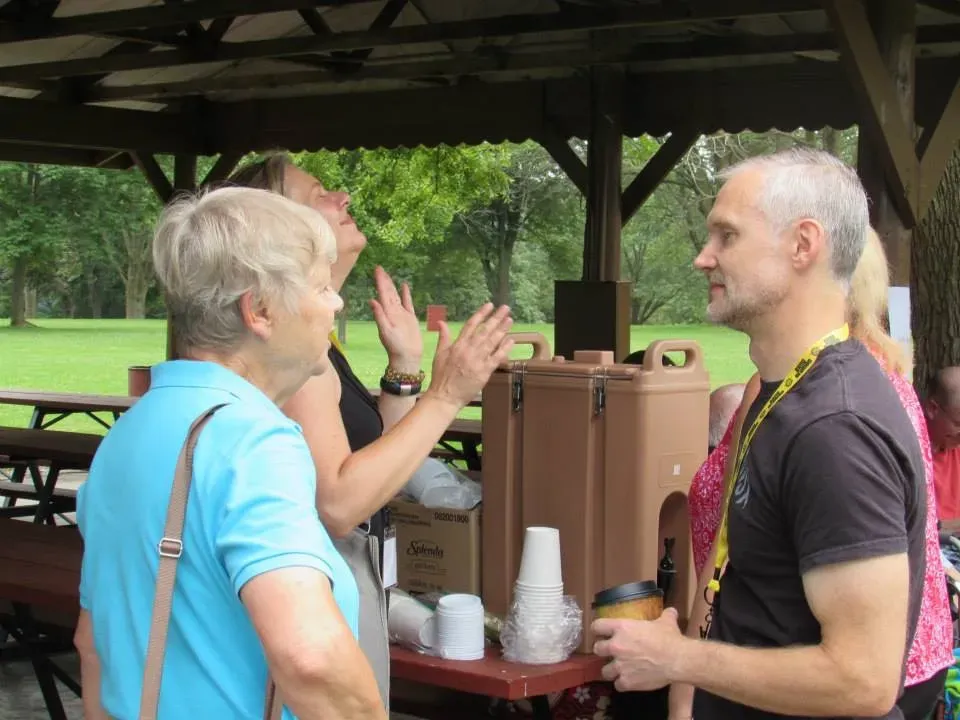
Sally Rynott was tireless. She was relentless. She never—absolutely never—expected less than 110% from us in all situations. But we learned the most important lessons of all. Lessons beyond any of the other classes I took. There is no substitute for doing the work. Practice and preparation are essential. We learned our scales—so that music became part of our muscle memory. We could pass an 8-to-5 marching test…multiple times…without looking down. And could do it each of our high school years. We practiced every day…sometimes arriving hours before school started…sometimes every dog day of August during the searing Illinois heat. We mentally simulated performances days and hours before taking the field or stage.
And most importantly, we learned to work together. We learned that we had to bring our best to teamwork. And only then could we succeed. To sacrifice our individual comfort for the common good. And, of course, we learned a love of music. A love that persisted through several bands I’ve played in since.
Ripple in Time Thinking
All actions have consequences. Some may be intended. Many are unintended. How we bring ourselves to act…and the values we bring to our actions…determine how positive or negative those actions ripple out.
Our actions—and how we engage with others—ripple out across the universe in ways we can’t predict or foresee. Some consequences loop around and impact us later. Decisions to put off fitness, healthy eating, and good sleep may show up years later as chronic disease. Ignoring our children for work now will come back around and lead to our being alone in old age—when The Cat’s in the Cradle comes true and our kids are too damn busy to see us.
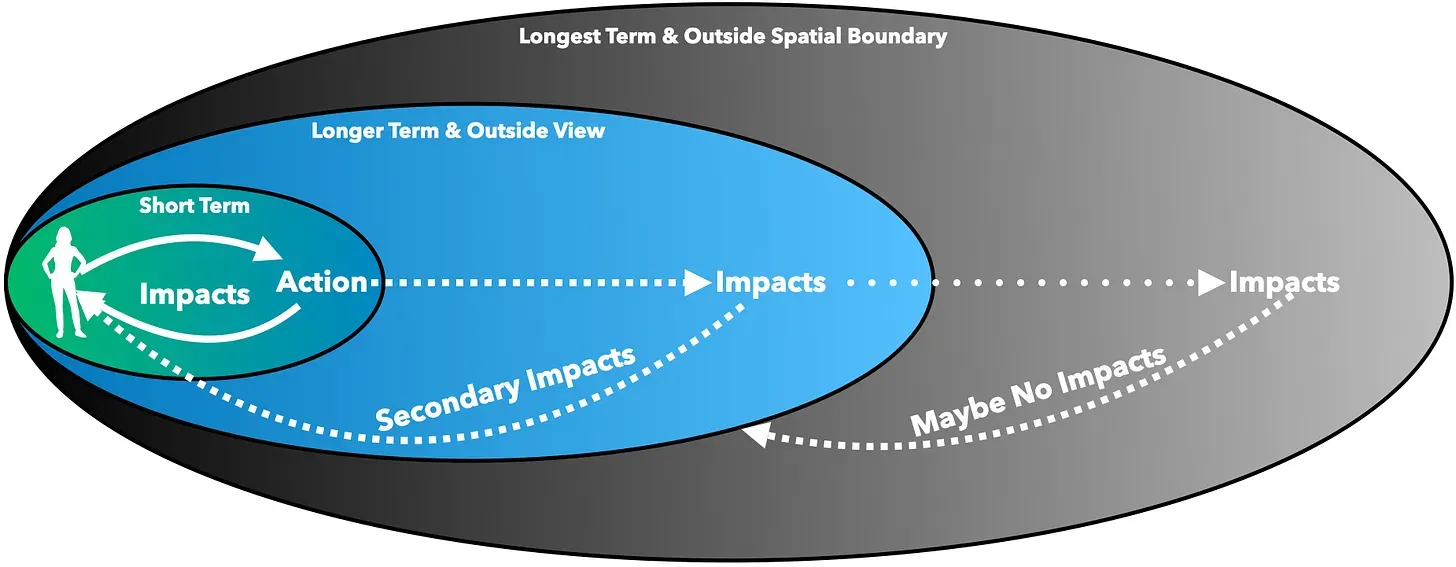 Not vaccinating the population…especially the youth…increases medical costs later. James Heckman, a Nobel Prize winning economist from the University of Chicago, declares that the US investing in early childhood education now is without question the biggest investment we can make to ensure that today’s generation will make our nation competitive in the decades ahead.
Not vaccinating the population…especially the youth…increases medical costs later. James Heckman, a Nobel Prize winning economist from the University of Chicago, declares that the US investing in early childhood education now is without question the biggest investment we can make to ensure that today’s generation will make our nation competitive in the decades ahead.
Sometime our actions impact others in ways that don’t feedback, and we don’t ever see the implications. The actions of John Wilkes Booth may still be playing out today. We can’t conceive of what the world would have been like had Lincoln led Reconstruction instead of his inept successor. Or if the assassin of Archduke Ferdinand hadn’t succeeded…which almost didn’t happen except for an unfortunate accident…would WWI have happened? And WWII?
Our band director—who flew back for this celebration—was fortunate to see how she had impacted all those who’d gone through her band programs. Millions of actions taken by each of us daily will impact others…and we will never know how.
Systems Being Lesson
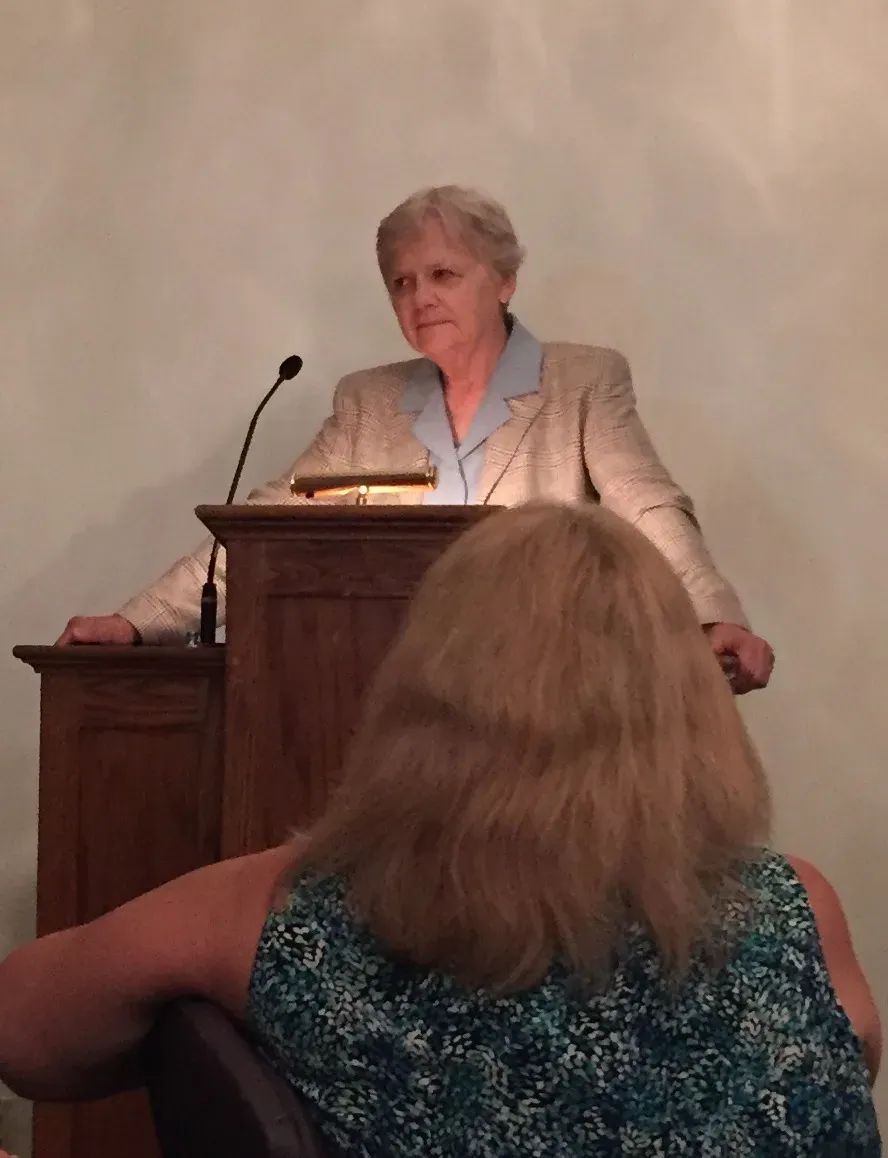
Our actions ripple out into the universe. That’s undeniable, whether we intend them to or not. What may matter most is the intent we bring to our actions.
The intent can fall along a continuum from necrophilic to biophilic. Erich Fromm described these two ends of a continuum. We can be more necrophilic by seeking and wallowing in death and devolution. We can be more biophilic by embracing love and constantly evolving, learning. The most affirmative way to life is by being as biophilic as possible—all the time.
When the goal is to cause pain and suffering…or when our actions occur through a lack of awareness and compassion…the long term ripple impacts will likely amplify the intent. But when the intent, like that of our band director’s, is biophilic—seeking the best of us at all times—the long term impacts will improve the lives of others. Of many. And can improve the planet.
Conclusion

I later watched the video from Karen. The young girl played one of my favorite songs: All I Want Is You by U2. The guitar playing was good. But the singing was amazing. As I watched her I could imagine her someday becoming another Taylor Swift or Lady Gaga. Mesmerizing.
Through tears I texted Karen back. “She’s great,” I texted. “But I’m curious. Why did you so badly want me to watch that video.”
“Don’t you remember?” she asked. “When you used to come over to my apartment and play that song. You would get lost in the music and I could feel it. That inspired me to play guitar. It was why I traded my acoustic guitar for your classical. Remember? And it’s why I teach that song to all my students now.”
That young girl never met my band director. But she was impacted just the same.
“All actions ripple out. They all leave traces. The intent behind our actions significantly determines the impact. Whether we know it or not.”
Finding High Leverage
Your organization doesn’t suffer from a lack of talent, technology, or resources. It suffers from mental models that prevent you from seeing the dynamics actually driving performance.
Contact UsResources
From decades of building systemic intelligence in organizations and communities, we’ve assembled resources to help you tackle complex problems more effectively. These videos, articles, and interactive tools are organized into four essential categories that together build your capacity to create lasting change. Each set develops a critical aspect of SysQ—from shifting your mindset to see systems differently, to following a proven learning process, to strengthening specific thinking skills, to mastering visualization tools that make the invisible visible. Whether you’re addressing organizational challenges, community issues, or global concerns, mastering these complementary resources will transform how you and your team approach complex challenges and implement high-leverage solutions.

Mind
mindset Test
MINDSET
Performance Framing Graph (PFG)
A trend over time graph — or reference behavior pattern — of the system behavior(s) you want to understand and improve by applying SysQ.
About
Performance Framing Graphs are powerful visual tools that map the interests, concerns, and performance metrics of diverse stakeholder groups within a system. These graphs reveal interconnections among different perspectives, expanding everyone's field of vision beyond their immediate concerns. By visually representing each stakeholder's key metrics over time, Performance Framing Graphs (PFGs) can:
-
facilitate cross-boundary collaboration
-
highlight potential tensions and synergies
-
support the development of more inclusive strategies
PFGs are particularly valuable in addressing complex adaptive challenges that span organizational boundaries because they translate diverse perspectives into actionable insights, balanced scorecards, and comprehensive performance indicators that reflect the whole system rather than isolated parts.

Case Studies
Private Sector | Production and Order Fulfillment for a Multinational Engine Company
A cross-siloed management team at an engine production company was assigned the task of improving production. The concerning issue was that average time between receiving an order and fulfilling it had been steadily climbing (with seasonality) over the past few years.
Highlights
Lorem ipsum dolor sit amet, consectetur adipiscing elit, sed do eiusmod tempor incididunt ut labore et dolore magna aliqua. Ut enim ad minim veniam, quis nostrud exercitation ullamco laboris nisi ut aliquip ex ea commodo consequat. Duis aute irure dolor in reprehenderit in voluptate velit esse cillum dolore eu fugiat nulla pariatur. Excepteur sint occaecat cupidatat non proident, sunt in culpa qui officia deserunt mollit anim id est laborum.
Lorem ipsum dolor sit amet, consectetur adipiscing elit, sed do eiusmod tempor incididunt ut labore et dolore magna aliqua. Ut enim ad minim veniam, quis nostrud exercitation ullamco laboris nisi ut aliquip ex ea commodo consequat. Duis aute irure dolor in reprehenderit in voluptate velit esse cillum dolore eu fugiat nulla pariatur. Excepteur sint occaecat cupidatat non proident, sunt in culpa qui officia deserunt mollit anim id est laborum.

Public Sector | Example of Public Sector
Lorem ipsum dolor sit amet, consectetur adipiscing elit, sed do eiusmod tempor incididunt ut labore et dolore magna aliqua. Ut enim ad minim veniam, quis nostrud exercitation ullamco laboris nisi ut aliquip ex ea commodo consequat. Duis aute irure dolor in reprehenderit in voluptate velit esse cillum dolore eu fugiat nulla pariatur. Excepteur sint occaecat cupidatat non proident, sunt in culpa qui officia deserunt mollit anim id est laborum.
Highlights
Lorem ipsum dolor sit amet, consectetur adipiscing elit, sed do eiusmod tempor incididunt ut labore et dolore magna aliqua. Ut enim ad minim veniam, quis nostrud exercitation ullamco laboris nisi ut aliquip ex ea commodo consequat. Duis aute irure dolor in reprehenderit in voluptate velit esse cillum dolore eu fugiat nulla pariatur. Excepteur sint occaecat cupidatat non proident, sunt in culpa qui officia deserunt mollit anim id est laborum.
Lorem ipsum dolor sit amet, consectetur adipiscing elit, sed do eiusmod tempor incididunt ut labore et dolore magna aliqua. Ut enim ad minim veniam, quis nostrud exercitation ullamco laboris nisi ut aliquip ex ea commodo consequat. Duis aute irure dolor in reprehenderit in voluptate velit esse cillum dolore eu fugiat nulla pariatur. Excepteur sint occaecat cupidatat non proident, sunt in culpa qui officia deserunt mollit anim id est laborum.

Value
Describe the value of using the mindset attribute
-
Lorem ipsum dolor sit amet, consectetur adipiscing elit, sed do eiusmod tempor incididunt ut labore et dolore magna aliqua. Ut enim ad minim veniam, quis nostrud exercitation ullamco laboris nisi ut aliquip ex ea commodo consequat. Duis aute irure dolor in reprehenderit in voluptate velit esse cillum dolore eu fugiat nulla pariatur. Excepteur sint occaecat cupidatat non proident, sunt in culpa qui officia deserunt mollit anim id est laborum.
-
Lorem ipsum dolor sit amet, consectetur adipiscing elit, sed do eiusmod tempor incididunt ut labore et dolore magna aliqua. Ut enim ad minim veniam, quis nostrud exercitation ullamco laboris nisi ut aliquip ex ea commodo consequat. Duis aute irure dolor in reprehenderit in voluptate velit esse cillum dolore eu fugiat nulla pariatur. Excepteur sint occaecat cupidatat non proident, sunt in culpa qui officia deserunt mollit anim id est laborum.
-
Lorem ipsum dolor sit amet, consectetur adipiscing elit, sed do eiusmod tempor incididunt ut labore et dolore magna aliqua. Ut enim ad minim veniam, quis nostrud exercitation ullamco laboris nisi ut aliquip ex ea commodo consequat. Duis aute irure dolor in reprehenderit in voluptate velit esse cillum dolore eu fugiat nulla pariatur. Excepteur sint occaecat cupidatat non proident, sunt in culpa qui officia deserunt mollit anim id est laborum.
How to Build
Instructions for the Individual
Follow the steps below or download the following link
- Step Name
Lorem ipsum dolor sit amet, consectetur adipiscing elit, sed do eiusmod tempor incididunt ut labore et dolore magna aliqua. Ut enim ad minim veniam, quis nostrud exercitation ullamco laboris nisi ut aliquip ex ea commodo consequat. Duis aute irure dolor in reprehenderit in voluptate velit esse cillum dolore eu fugiat nulla pariatur. Excepteur sint occaecat cupidatat non proident, sunt in culpa qui officia deserunt mollit anim id est laborum.
-
Lorem ipsum dolor sit amet, consectetur adipiscing elit, sed do eiusmod tempor incididunt ut labore et dolore magna aliqua. Ut enim ad minim veniam, quis nostrud exercitation ullamco laboris nisi ut aliquip ex ea commodo consequat. Duis aute irure dolor in reprehenderit in voluptate velit esse cillum dolore eu fugiat nulla pariatur. Excepteur sint occaecat cupidatat non proident, sunt in culpa qui officia deserunt mollit anim id est laborum.
-
Lorem ipsum dolor sit amet, consectetur adipiscing elit, sed do eiusmod tempor incididunt ut labore et dolore magna aliqua. Ut enim ad minim veniam, quis nostrud exercitation ullamco laboris nisi ut aliquip ex ea commodo consequat. Duis aute irure dolor in reprehenderit in voluptate velit esse cillum dolore eu fugiat nulla pariatur. Excepteur sint occaecat cupidatat non proident, sunt in culpa qui officia deserunt mollit anim id est laborum.
-
Lorem ipsum dolor sit amet, consectetur adipiscing elit, sed do eiusmod tempor incididunt ut labore et dolore magna aliqua. Ut enim ad minim veniam, quis nostrud exercitation ullamco laboris nisi ut aliquip ex ea commodo consequat. Duis aute irure dolor in reprehenderit in voluptate velit esse cillum dolore eu fugiat nulla pariatur. Excepteur sint occaecat cupidatat non proident, sunt in culpa qui officia deserunt mollit anim id est laborum.
- Step Name
Lorem ipsum dolor sit amet, consectetur adipiscing elit, sed do eiusmod tempor incididunt ut labore et dolore magna aliqua. Ut enim ad minim veniam, quis nostrud exercitation ullamco laboris nisi ut aliquip ex ea commodo consequat. Duis aute irure dolor in reprehenderit in voluptate velit esse cillum dolore eu fugiat nulla pariatur. Excepteur sint occaecat cupidatat non proident, sunt in culpa qui officia deserunt mollit anim id est laborum.
-
Lorem ipsum dolor sit amet, consectetur adipiscing elit, sed do eiusmod tempor incididunt ut labore et dolore magna aliqua. Ut enim ad minim veniam, quis nostrud exercitation ullamco laboris nisi ut aliquip ex ea commodo consequat. Duis aute irure dolor in reprehenderit in voluptate velit esse cillum dolore eu fugiat nulla pariatur. Excepteur sint occaecat cupidatat non proident, sunt in culpa qui officia deserunt mollit anim id est laborum.
-
Lorem ipsum dolor sit amet, consectetur adipiscing elit, sed do eiusmod tempor incididunt ut labore et dolore magna aliqua. Ut enim ad minim veniam, quis nostrud exercitation ullamco laboris nisi ut aliquip ex ea commodo consequat. Duis aute irure dolor in reprehenderit in voluptate velit esse cillum dolore eu fugiat nulla pariatur. Excepteur sint occaecat cupidatat non proident, sunt in culpa qui officia deserunt mollit anim id est laborum.
-
Lorem ipsum dolor sit amet, consectetur adipiscing elit, sed do eiusmod tempor incididunt ut labore et dolore magna aliqua. Ut enim ad minim veniam, quis nostrud exercitation ullamco laboris nisi ut aliquip ex ea commodo consequat. Duis aute irure dolor in reprehenderit in voluptate velit esse cillum dolore eu fugiat nulla pariatur. Excepteur sint occaecat cupidatat non proident, sunt in culpa qui officia deserunt mollit anim id est laborum.
Instructions for Teams
Follow the steps below or download the following link
- Step Name
Lorem ipsum dolor sit amet, consectetur adipiscing elit, sed do eiusmod tempor incididunt ut labore et dolore magna aliqua. Ut enim ad minim veniam, quis nostrud exercitation ullamco laboris nisi ut aliquip ex ea commodo consequat. Duis aute irure dolor in reprehenderit in voluptate velit esse cillum dolore eu fugiat nulla pariatur. Excepteur sint occaecat cupidatat non proident, sunt in culpa qui officia deserunt mollit anim id est laborum.
-
Lorem ipsum dolor sit amet, consectetur adipiscing elit, sed do eiusmod tempor incididunt ut labore et dolore magna aliqua. Ut enim ad minim veniam, quis nostrud exercitation ullamco laboris nisi ut aliquip ex ea commodo
consequat. Duis aute irure dolor in reprehenderit in voluptate velit esse cillum dolore eu fugiat nulla pariatur. Excepteur sint occaecat cupidatat non proident, sunt in culpa qui officia deserunt mollit anim id est laborum. -
Lorem ipsum dolor sit amet, consectetur adipiscing elit, sed do eiusmod tempor incididunt ut labore et dolore magna aliqua. Ut enim ad minim veniam, quis nostrud exercitation ullamco laboris nisi ut aliquip ex ea commodo
consequat. Duis aute irure dolor in reprehenderit in voluptate velit esse cillum dolore eu fugiat nulla pariatur. Excepteur sint occaecat cupidatat non proident, sunt in culpa qui officia deserunt mollit anim id est laborum. -
Lorem ipsum dolor sit amet, consectetur adipiscing elit, sed do eiusmod tempor incididunt ut labore et dolore magna aliqua. Ut enim ad minim veniam, quis nostrud exercitation ullamco laboris nisi ut aliquip ex ea commodo
consequat. Duis aute irure dolor in reprehenderit in voluptate velit esse cillum dolore eu fugiat nulla pariatur. Excepteur sint occaecat cupidatat non proident, sunt in culpa qui officia deserunt mollit anim id est laborum.
- Step Name
Lorem ipsum dolor sit amet, consectetur adipiscing elit, sed do eiusmod tempor incididunt ut labore et dolore magna aliqua. Ut enim ad minim veniam, quis nostrud exercitation ullamco laboris nisi ut aliquip ex ea commodo consequat. Duis aute irure dolor in reprehenderit in voluptate velit esse cillum dolore eu fugiat nulla pariatur. Excepteur sint occaecat cupidatat non proident, sunt in culpa qui officia deserunt mollit anim id est laborum.
-
Lorem ipsum dolor sit amet, consectetur adipiscing elit, sed do eiusmod tempor incididunt ut labore et dolore magna aliqua. Ut enim ad minim veniam, quis nostrud exercitation ullamco laboris nisi ut aliquip ex ea commodo
consequat. Duis aute irure dolor in reprehenderit in voluptate velit esse cillum dolore eu fugiat nulla pariatur. Excepteur sint occaecat cupidatat non proident, sunt in culpa qui officia deserunt mollit anim id est laborum. -
Lorem ipsum dolor sit amet, consectetur adipiscing elit, sed do eiusmod tempor incididunt ut labore et dolore magna aliqua. Ut enim ad minim veniam, quis nostrud exercitation ullamco laboris nisi ut aliquip ex ea commodo
consequat. Duis aute irure dolor in reprehenderit in voluptate velit esse cillum dolore eu fugiat nulla pariatur. Excepteur sint occaecat cupidatat non proident, sunt in culpa qui officia deserunt mollit anim id est laborum. -
Lorem ipsum dolor sit amet, consectetur adipiscing elit, sed do eiusmod tempor incididunt ut labore et dolore magna aliqua. Ut enim ad minim veniam, quis nostrud exercitation ullamco laboris nisi ut aliquip ex ea commodo
consequat. Duis aute irure dolor in reprehenderit in voluptate velit esse cillum dolore eu fugiat nulla pariatur. Excepteur sint occaecat cupidatat non proident, sunt in culpa qui officia deserunt mollit anim id est laborum.
Connections to Other SysQ Components
Describe the value of using the mindset attribute
- SysQ Mindset
Lorem ipsum dolor sit amet, consectetur adipiscing elit, sed do eiusmod tempor incididunt ut labore et dolore magna aliqua. Ut enim ad minim veniam, quis nostrud exercitation ullamco laboris nisi ut aliquip ex ea commodo consequat. Duis aute irure dolor in reprehenderit in voluptate velit esse cillum dolore eu fugiat nulla pariatur. Excepteur sint occaecat cupidatat non proident, sunt in culpa qui officia deserunt mollit anim id est laborum. Learn more
- SysQ Process
Lorem ipsum dolor sit amet, consectetur adipiscing elit, sed do eiusmod tempor incididunt ut labore et dolore magna aliqua. Ut enim ad minim veniam, quis nostrud exercitation ullamco laboris nisi ut aliquip ex ea commodo consequat. Duis aute irure dolor in reprehenderit in voluptate velit esse cillum dolore eu fugiat nulla pariatur. Excepteur sint occaecat cupidatat non proident, sunt in culpa qui officia deserunt mollit anim id est laborum. Learn more
- SysQ Thinking
Description. Lorem ipsum dolor sit amet, consectetur adipiscing elit, sed do eiusmod tempor incididunt ut labore et dolore magna aliqua. Ut enim ad minim veniam, quis nostrud exercitation ullamco laboris nisi ut aliquip ex ea commodo consequat. Duis aute irure dolor in reprehenderit in voluptate velit esse cillum dolore eu fugiat nulla pariatur. Excepteur sint occaecat cupidatat non proident, sunt in culpa qui officia deserunt mollit anim id est laborum.
This tool is essential for these steps:
- Step Name
Lorem ipsum dolor sit amet, consectetur adipiscing elit, sed do eiusmod tempor incididunt ut labore et dolore magna aliqua. Ut enim ad minim veniam, quis nostrud exercitation ullamco laboris nisi ut aliquip ex ea commodo consequat. Duis aute irure dolor in reprehenderit in voluptate velit esse cillum dolore eu fugiat nulla pariatur. Excepteur sint occaecat cupidatat non proident, sunt in culpa qui officia deserunt mollit anim id est laborum.Learn more
- Step Name
Lorem ipsum dolor sit amet, consectetur adipiscing elit, sed do eiusmod tempor incididunt ut labore et dolore magna aliqua. Ut enim ad minim veniam, quis nostrud exercitation ullamco laboris nisi ut aliquip ex ea commodo consequat. Duis aute irure dolor in reprehenderit in voluptate velit esse cillum dolore eu fugiat nulla pariatur. Excepteur sint occaecat cupidatat non proident, sunt in culpa qui officia deserunt mollit anim id est laborum. Learn more
- Step Name
Lorem ipsum dolor sit amet, consectetur adipiscing elit, sed do eiusmod tempor incididunt ut labore et dolore magna aliqua. Ut enim ad minim veniam, quis nostrud exercitation ullamco laboris nisi ut aliquip ex ea commodo consequat. Duis aute irure dolor in reprehenderit in voluptate velit esse cillum dolore eu fugiat nulla pariatur. Excepteur sint occaecat cupidatat non proident, sunt in culpa qui officia deserunt mollit anim id est laborum. Learn more
Conclusion
Lorem ipsum dolor sit amet, consectetur adipiscing elit, sed do eiusmod tempor incididunt ut labore et dolore magna aliqua. Ut enim ad minim veniam, quis nostrud exercitation ullamco laboris nisi ut aliquip ex ea commodo consequat. Duis aute irure dolor in reprehenderit in voluptate velit esse cillum dolore eu fugiat nulla pariatur. Excepteur sint occaecat cupidatat non proident, sunt in culpa qui officia deserunt mollit anim id est laborum.
Lorem ipsum dolor sit amet, consectetur adipiscing elit, sed do eiusmod tempor incididunt ut labore et dolore magna aliqua. Ut enim ad minim veniam, quis nostrud exercitation ullamco laboris nisi ut aliquip ex ea commodo consequat. Duis aute irure dolor in reprehenderit in voluptate velit esse cillum dolore eu fugiat nulla pariatur. Excepteur sint occaecat cupidatat non proident, sunt in culpa qui officia deserunt mollit anim id est laborum.
Additional Resources
Books
Book title as link | Description
Articles
Article title as link | Description
Online Resources
Resource title as link | Description

Process
🛣️ The Process Redux: The Learning Journey Takes the High Road
PROCESS
Attribute of Process
Lorem ipsum dolor sit amet, consectetur adipiscing elit, sed do eiusmod tempor incididunt ut labore et dolore magna aliqua
About
Overview of the attribute. Lorem ipsum dolor sit amet, consectetur adipiscing elit, sed do eiusmod tempor incididunt ut labore et dolore magna aliqua. Ut enim ad minim veniam, quis nostrud exercitation ullamco laboris nisi ut aliquip ex ea commodo consequat. Duis aute irure dolor in reprehenderit in voluptate velit esse cillum dolore eu fugiat nulla pariatur. Excepteur sint occaecat cupidatat non proident, sunt in culpa qui officia deserunt mollit anim id est laborum.
We tend to focus on the present moment. Most PhDs are awarded for studying a single weed in a field and analyzing it in great detail.
Good systems models, on the other hand, take a broader perspective.
They look at the big picture, analyzing long-term patterns and trends to find ways to improve things over time.
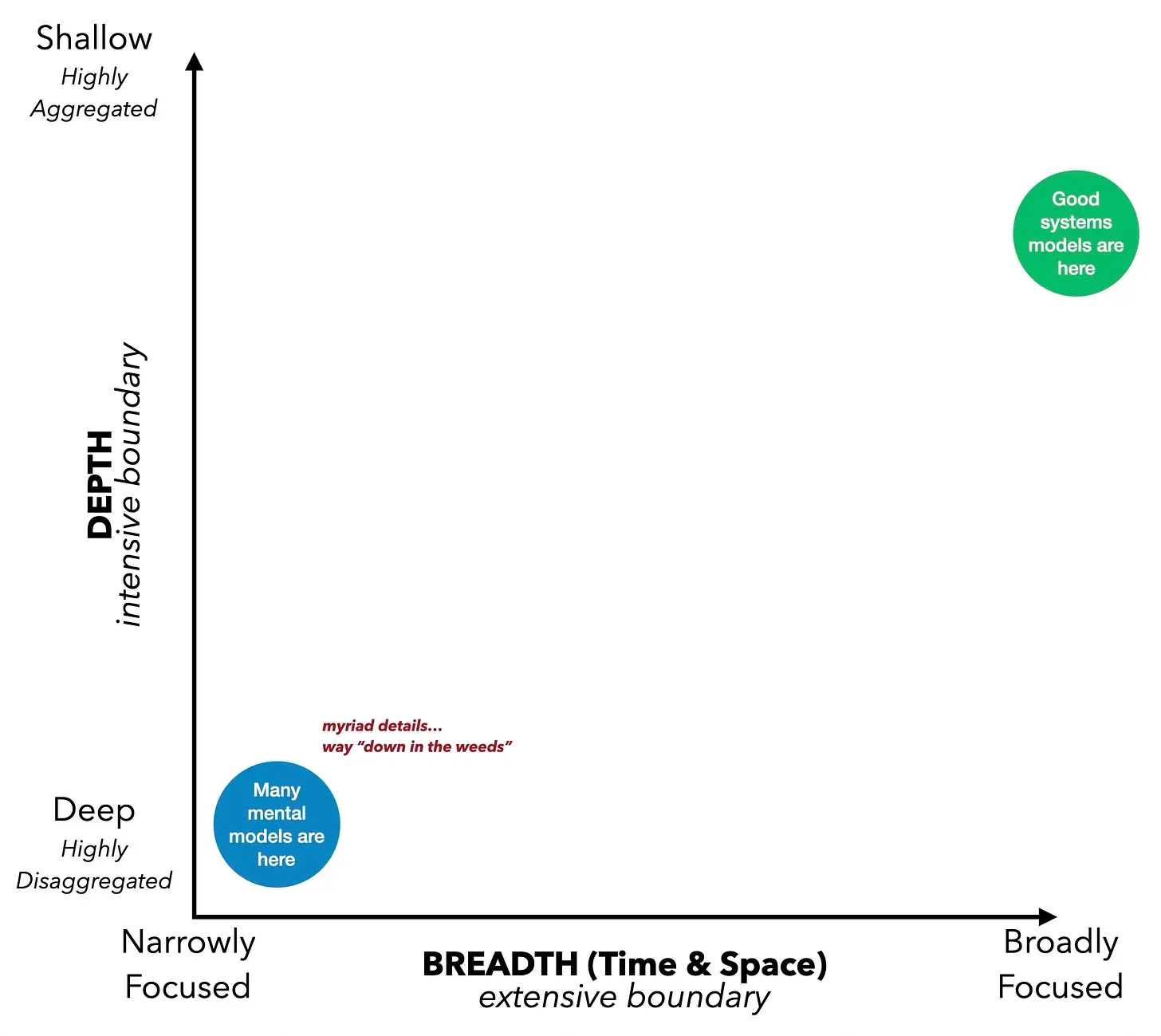
Most mental models are confined to a narrow window of time and space. We usually focus on a few days or weeks, while the system operates over years. Similarly, we usually concentrate on our department or division, but to effectively manage the system, we need to consider multiple organizations, agencies, groups, and stakeholders.
HOW DEEP (DETAILED)?
You may have heard that adaptive leaders should step back from the action and take a look at the big picture. It can feel like we’re stuck in the weeds, and it’s hard to see the shared values and beliefs that guide our interactions with others. Instead of focusing on individual differences, it’s helpful to apply a broader context (FOREST Thinking) — see how forces and conditions in the ecosystem shape our actions. Public health professionals deal with large numbers of people, while marketing departments manage diverse customer groups.
HOW TO BUILD GOOD SYSTEMS MODELS
Good systems models are in the upper right. They see broadly to understand the forces across the full ecosystem responsible for the performance issues you want to improve. The goal is to generate good systems models. The challenge? How to get there!
There are two roads we could take to reach the destination of a useful systems model.
Road 1: Representing the System
Road 1 is the most popular path. It tries to make a complete map of everything from the start. Teams of experts with specific knowledge often try to put all their knowledge together into a detailed picture. But this can make the map too complicated — like the Afghanistan Counterinsurgency map — with too much detail. This pursuit of a complete system map puts us on the Low Road (Road 1).
The Low Road starts with myopic perspectives and ideas and tries to put them together into a coherent whole. Since we have so much detail and the task is so big, this process only makes things more complicated. If we’re lucky, the mapping project ends up with a map as complex as the counterinsurgency map — a tangled web of information. More likely, the mapping effort stops, leaving us lacking comprehension and insight.
The problem is trying to map the whole system instead of just understanding the cause of the behavior (performance measure) we want to improve. Remember the slinky. If our performance goal is to significantly reduce the Slinky’s oscillation, we only need to focus on the physics of the spring. We can leave out colors and shapes — in fact, we must exclude them to reduce complexity. For usability, we must eliminate parts of the full system that don’t contribute to the performance we want to improve.
“Details are confusing.
It is only by selection, by elimination, by emphasis, that we get at the real meaning of things.”
—Georgia O’Keefe
Road 2: Get Up Out of the Weeds
Road 2 is the wisest path. It is the High Road path.1
The High Road starts by setting the big picture vision for system performance. Then, you can decide what you want to see improve. Next, you can build a simple causal map, pick and change a system archetype, or make a simulation model. These tools help you understand what causes that behavior.
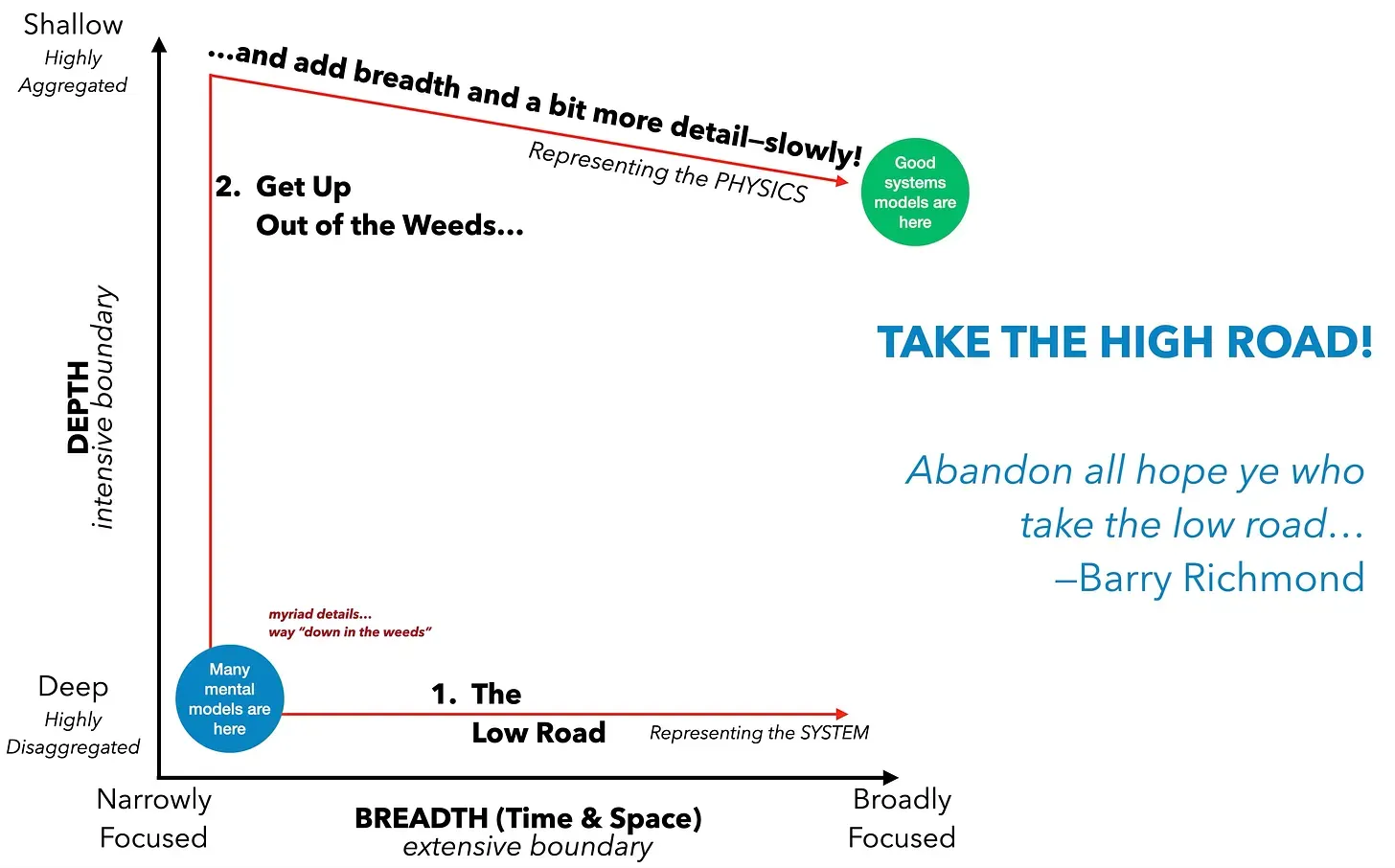 The High Road process involves sharing the initial “starter map” or “starter model” with others. Does it provide a clear explanation of why the performance issue is occurring? What changes or additions are needed? Make small adjustments and share the updated model for testing.
The High Road process involves sharing the initial “starter map” or “starter model” with others. Does it provide a clear explanation of why the performance issue is occurring? What changes or additions are needed? Make small adjustments and share the updated model for testing.
Keep adding more details a little at a time. This is the gradual descent in the diagram labeled “and add breadth and a bit more detail — slowly”.
Apply OPERATIONAL Thinking when adding more elements. Answer the question: “Does this contribute to the physics of the challenge — does it explain how the performance is generated?”
When you can finally answer the question “Does this describe the essential drivers of the performance issue?” with “Yes!”, it’s time to stop mapping (or whatever SysQ analysis process you’re applying.
Then use the map or analysis to start exploring ways to improve performance. You can look for solutions to close the future performance gap — you can find interventions to achieve your vision.
“A model should be as simple as possible, but no simpler.”
—Albert Einstein
The concept of two roads, and especially the High Road, was first developed by Barry Richmond while teaching system dynamics to his undergraduate class. The concept was so memorable that one of his students years later asked me if I had a Powerpoint slide with the roads on it.
Additional Resources
Books
Book title as link | Description
Articles
Article title as link | Description
Online Resources
Resource title as link | Description
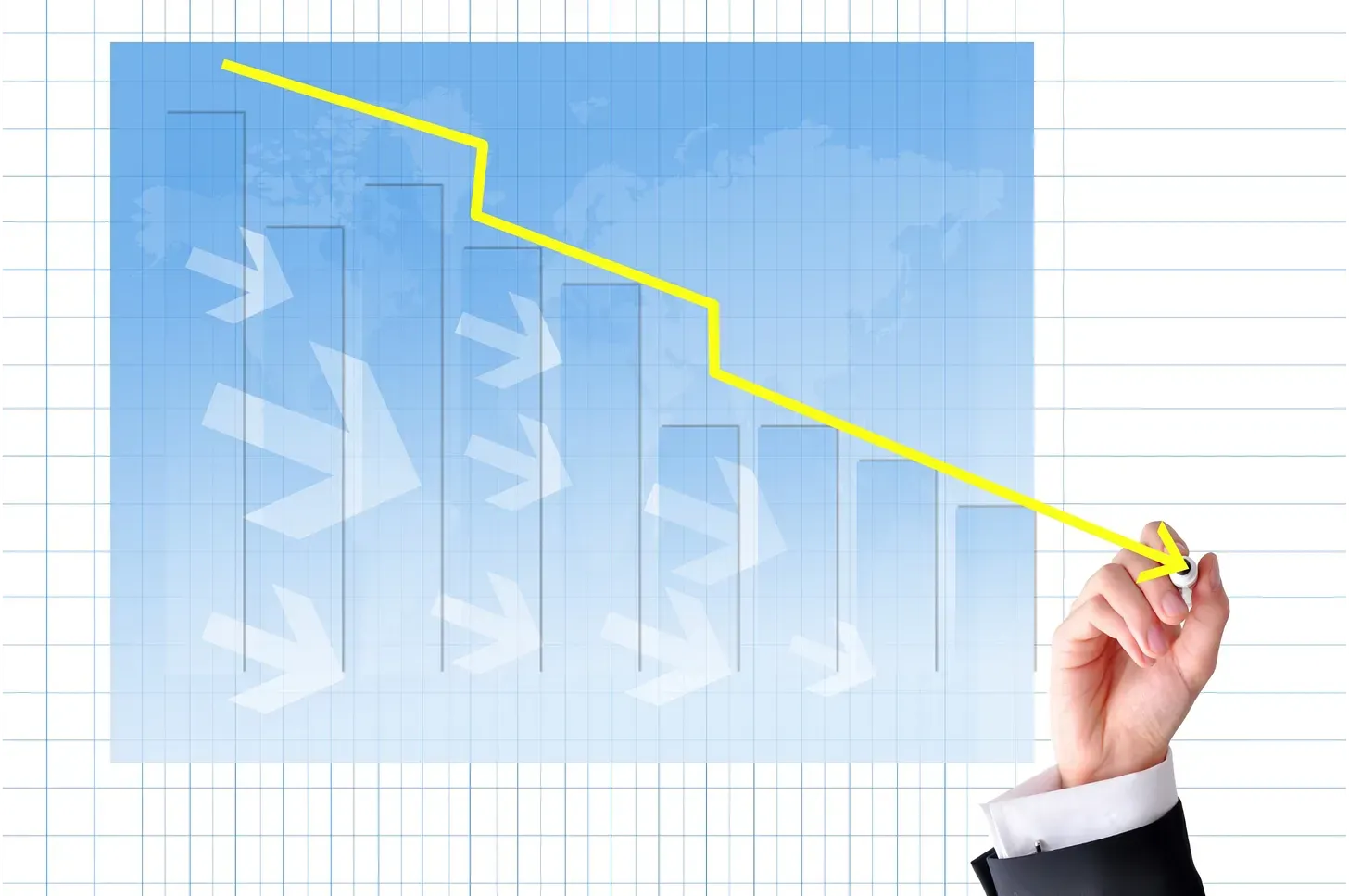
Skills
🧠 DYNAMIC Thinking
SKILLS
Attribute of Skills
Lorem ipsum dolor sit amet, consectetur adipiscing elit, sed do eiusmod tempor incididunt ut labore et dolore magna aliqua
About
Overview of the attribute. Lorem ipsum dolor sit amet, consectetur adipiscing elit, sed do eiusmod tempor incididunt ut labore et dolore magna aliqua. Ut enim ad minim veniam, quis nostrud exercitation ullamco laboris nisi ut aliquip ex ea commodo consequat. Duis aute irure dolor in reprehenderit in voluptate velit esse cillum dolore eu fugiat nulla pariatur. Excepteur sint occaecat cupidatat non proident, sunt in culpa qui officia deserunt mollit anim id est laborum.
"We count by years, but we live by days. Rightfully, we should do both by seasons." — Ivan Doig, Dancing at the Rascal Fair
YOU’RE ON A COMPANY’S EXECUTIVE TEAM
Imagine you’re on the senior executive team of a multimillion-dollar company. Last quarter’s financial statement just came out, and it’s a doozy. Your company lost several million dollars. How do you feel?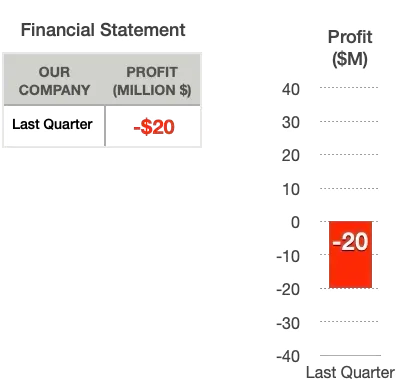 Bad, right? Worried?
Bad, right? Worried?
What ideas / actions do you think the executive team would discuss and probably implement? If like most companies, you’d consider:
-
Lay offs?
-
Travel restrictions?
-
Training reductions?
-
Several other cost cutting strategies?
Now suppose you were shown the graph drawn below. Profit has plummeted over the past six months. 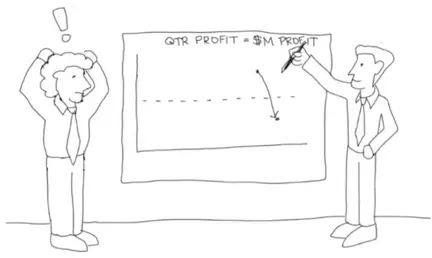
How do you feel now?
Even worse!
Why? Because it looks like things are getting worse–and rapidly!
What ideas or actions do you think the executive team would discuss and likely implement? If you’re like most companies, you might consider:
-
Hiring a consulting firm?
-
Closing part of the business?
-
Ending a product line?
And as an individual on the team you are concerned about a few things. There is probably going to be some personnel changes on the leadership team. The CEO might be let go. The board will certainly be looking for someone to blame.
You? You are most likely improving your resume, contacting friends and colleagues in your network–spending a lot of time on LinkedIn.
Now, suppose you’re shown this graph. Now how do you feel?
Now how do you feel?
Relieved, right? You may notice even a slight relaxing in the body now (if you were reacting at all to the exercise).
Why relieved?
Because, when viewed over a longer time horizon, the plummeting profits are part of a larger, predictable pattern.
If I asked you what type of business you’re running, you might say it’s a commodity business or more likely a seasonal business (since it has the same fluctuations at the same time each year). Maybe you’re a winter sports chain in New England, selling mostly skis and snowboards.
If it’s a seasonal business (like the winter sports chain) what solutions might you suggest?
You might suggest the following:
Closing the business in the summer months
Diversifying (sell golf clubs!)
Investing during the summer months to boost sales in the winter
Compare the solutions you would propose when analyzing the broader pattern to those you would suggest based solely on quarterly results (an event) or just a half-year’s worth of data (a small window).
The newer solutions are proactive, giving you more control and often revealing opportunities to generate additional revenue. In contrast, the reactive solutions focus on cutting costs.
The key difference between reactive and proactive solutions lies in your understanding of the business’s nature. It’s like seeing the slinky. You grasp the business’s structure, which is seasonal. Once you understand this structure, you can develop a much more effective solution tailored to your business.
EVENT THINKING VS. DYNAMIC THINKING
From a young age, our minds naturally focus on events and behaviors that occur right in front of us, both in space and time. This is not surprising, as humans are hardwired to prioritize the immediate and the present. The ability to hyper-focus on a predator that suddenly leaps from the bushes and react swiftly has proven beneficial to our species. There’s no need to meticulously chart the long-term history of predators leaping from bushes and consuming humans; the immediate response is sufficient: run!
What sets humans apart from other animals is an additional skill: the ability to discern patterns and make predictions. This higher level of consciousness, our meta-level thinking, is essential for addressing adaptive challenges. Our mental models must also include the capacity to represent patterns and make predictions.
In the context of terrorism, it is common in the United States to focus on a single event like 9/11, while overlooking the long history of observable behaviors that could have predicted it. There had been escalating tensions, punctuated by events such as the bombing of the USS Cole and the subsequent US response, as well as actions by the US that supported those considered enemies of terrorist organizations. Adopting a broader, longer-term perspective enhances the quality of any mental model attempting to understand the expansion of terrorism—it helps us identify the causal structures driving it.
Organizations often focus on recent events, such as the last quarter’s profit margin, this week’s layoffs, or current scandals. For instance, the 2008 mortgage crisis in the US (and globally) is a notable example. Initially, in mid-2008, people believed it was a recent phenomenon, likely due to poor management decisions by a few. However, a longer-term perspective reveals that the US economy since the 2000 “sell-off” was stimulated by lower interest rates set by the Federal Reserve. Additionally, granting subprime loans increased at a much faster rate than disposable incomes could sustain. In response, the Federal Reserve resorted to lowering interest rates once again to address the crisis.
The power of an event is undeniable, but unfortunately, we often react impulsively to it. Layoffs, reassignments, extra bureaucratic oversight, and even military invasions are common knee-jerk responses. However, understanding the world and its causes requires the ability to identify patterns of behavior.
REDUCING YOUR STATE’S MEDICAL COSTS
You’re working on your state’s initiative to reverse the rising medical costs. You’ve selected two states to benchmark, and based on their performance, you’ll contact your counterpart in each state to learn from their strategies.
Here are the per capita medical costs for two states. Which one, based solely on this data, would you choose as your benchmark for “best practices”?
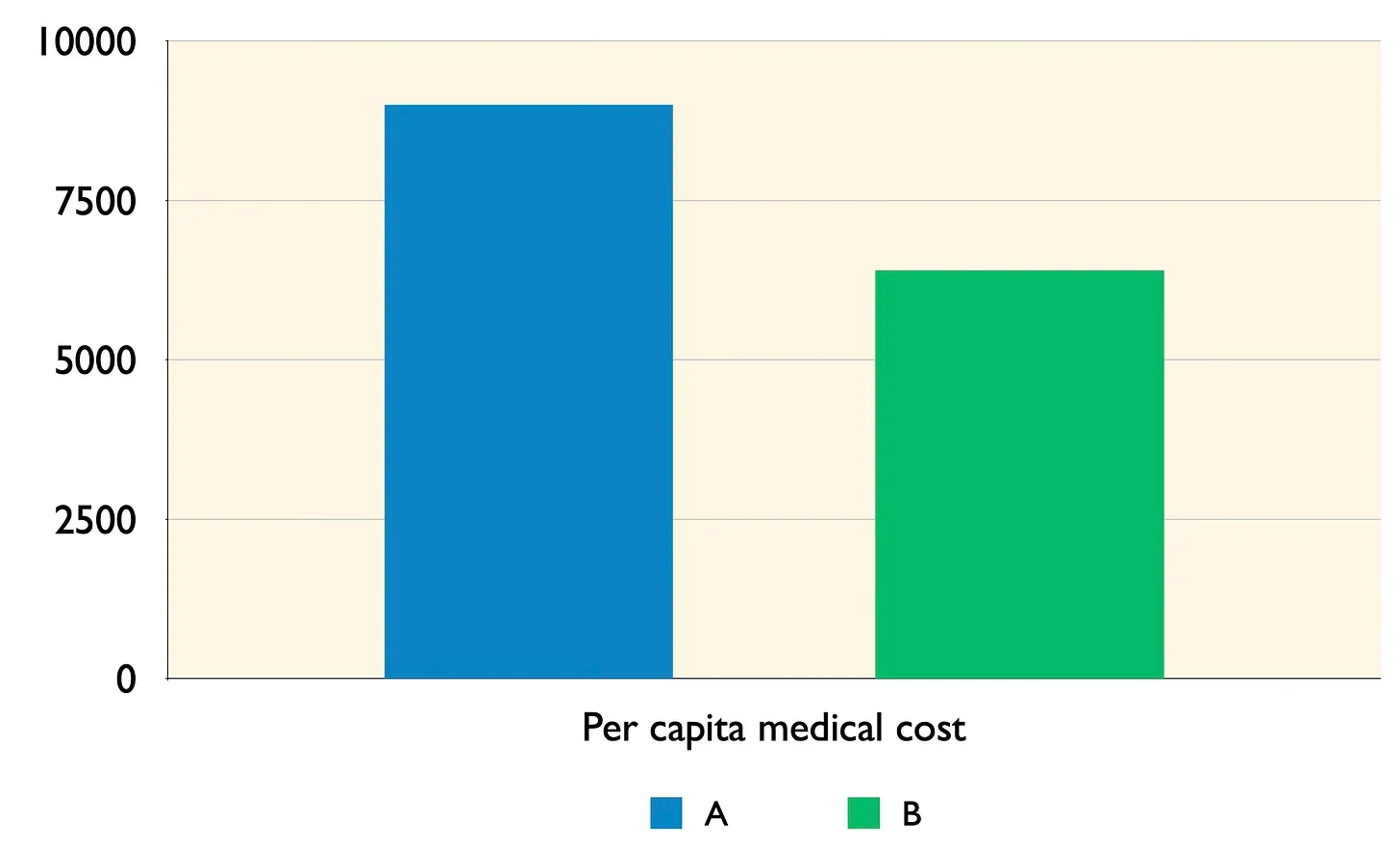
he obvious answer is State B.
However, before you draft an email to your counterpart in State B, your assistant bursts into the room with this chart. Now, which state should you contact to learn from their successful practices?
This time the answer is State A.
This illustrates why it’s often beneficial to analyze metrics through the DYNAMIC Thinking lens. First, relying solely on “point in time” data can lead to incorrect conclusions. We frequently make decisions based on narrow time slices of data, which could be detrimental.
Second, comparisons between similar entities, such as states vs. states, cities vs. cities, or countries vs. countries, that only use single numbers can be misleading. Even if two states have the same per capita medical costs, if their trends are similar to those observed here, one may be experiencing rapid deterioration. They are not comparable at all.
Trend lines, on the other hand, often trigger deeper, more rigorous mental models. They provide an operational narrative that enhances our thinking, decisions, and strategies. In this case, observing the trends revealed a story about the direction of performance and clarified the clear winner.
So a good SysQ tenet is:
When something’s important, look at it as a trend over time.
TIME DELAYS: ANOTHER REASON WE NEED DYNAMIC THINKING
In many cases, decisions made today may not have a desired impact on the organization for years. For instance, the Beer Game, a popular learning tool, illustrates our inability to comprehend time delays. Thousands of executives, MBA students, engineers, and others who have played this game have struggled to manage their inventories, even when the retail demand is linear and predictable. Anyone who has played this game understands how inherent time delays in a system’s structure contribute to its performance.
This common limitation also affects our understanding of climate change. John Sterman and Linda Booth-Sweeney have shown that a majority of their subjects (MIT students) cannot predict how long it will take a decrease in carbon emissions rates to impact global climate temperatures, even when the assumptions are clearly stated.1
Ignoring time delays is a major contributor to the planning fallacy. This fallacy occurs when our predictions about the time required to complete a future task are overly optimistic, leading us to underestimate the actual time needed.
Overlooking time delays often results in the common “worse before better” dynamic when implementing public policies or organizational improvements. Public sector managers, rightly so given the public’s understanding of dynamics, avoid policies that may eventually improve situations in the long run but may worsen conditions in the short term.2
THE SHAPE OF A MOVIE
In 2017, we witnessed a plethora of extraordinary yet peculiar movies. Among them, The Shape of Water emerged as the most peculiar of all, potentially claiming the coveted Academy Award for Best Picture.

Its premise, centered around a mute woman named Elisa’s profound love for a creature that resembles a fish more than a human, may initially appear absurd or even laughable. However, this film achieved remarkable success, garnering numerous accolades and captivating audiences.
The trend line for her love of the water man is shown here.
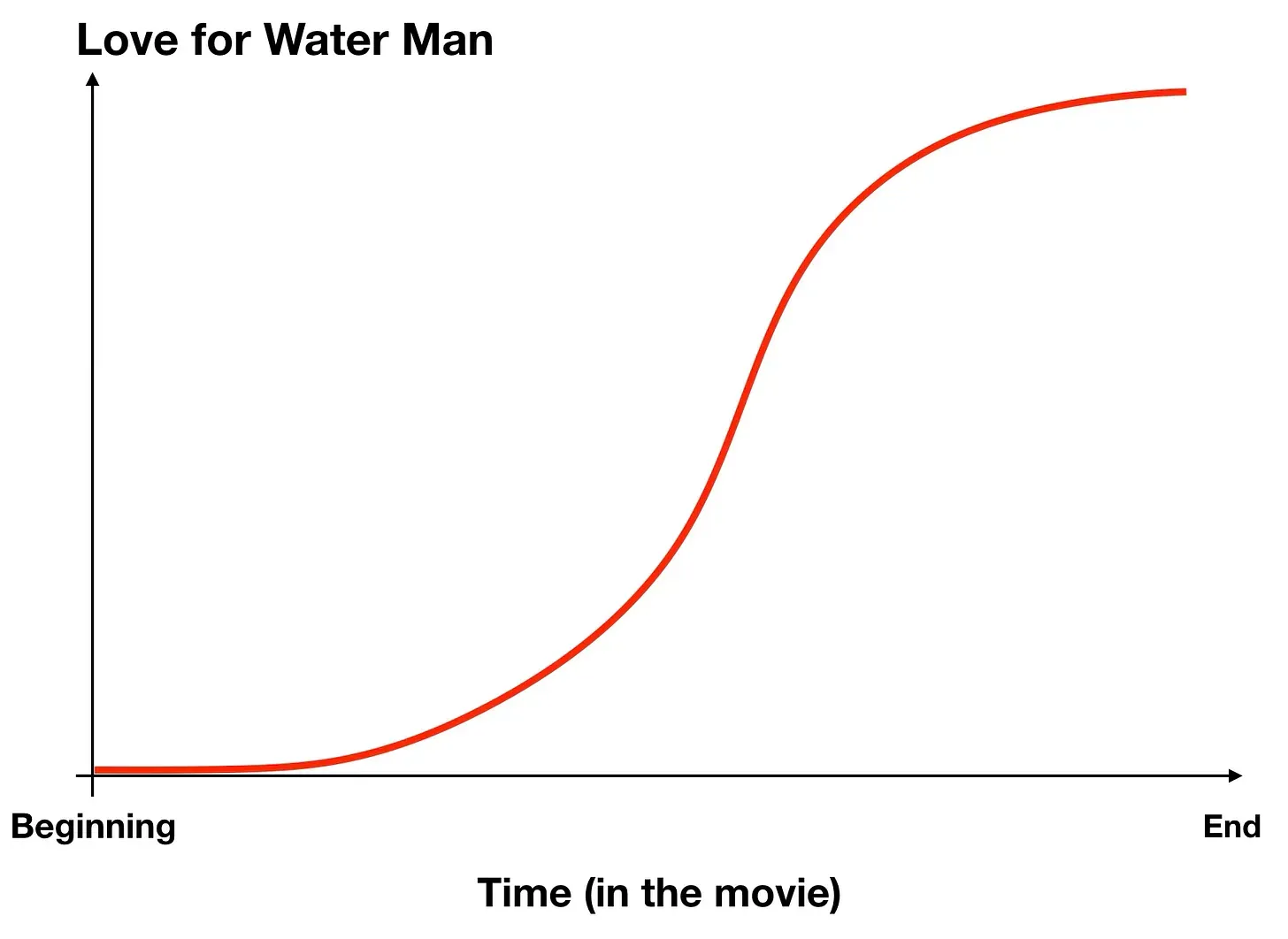
The Shape of Water’s success lies in its ability to gradually reveal credible reasons for Elisa’s growing affection for the water-dwelling entity. This gradual progression allows viewers to comprehend and even predict her actions throughout the movie. If you were to watch only the last third of the film, you might find the scenes so absurd that they would be difficult to take seriously, potentially leading you to leave the theater.
However, by watching the entire movie from the beginning, you are presented with a rational, rigorous, and dynamic mental model that enables you to grasp and even anticipate the protagonist’s actions.
STARTING A SYSQ ANALYSIS? FIND THE PLOT FIRST!
At the outset of every SysQ initiative, establish a clear purpose. Collaborate with your team members and stakeholders who need to be involved. Ensure that everyone is aligned in understanding the purpose of the mapping, modeling, or SysQ analysis.
The purpose is to comprehend the underlying causal factors that contribute to ____________. This knowledge will enable us to develop more effective strategies, policies, or levers to influence ____________ in the future.
While verbal descriptions can suffice, visualizing trends over time through a trend graph can significantly enhance the impact and utility of the analysis, particularly in collaborative settings.
OPERATIONAL THINKING — FOCUSING ON THE PHYSICS — REQUIRES CLARITY ON THE TRENDS
OPERATIONAL Thinking — focusing on the physics — is fundamental to high SysQ and applying it involves gaining a comprehensive understanding of the systemic structure that generates the desired behavior. Clarity on the behavior is not merely a desirable outcome but a prerequisite for effective SysQ application.
The process of clarifying the trends, drawing and agreeing on these trends, aligns everyone on the same page regarding their underlying reasons for working together. It provides a clear vision, fostering strong motivation for collaboration. Therefore, I allocate significant time early in any consulting engagement to assist my clients in achieving vivid and rigorous clarity on the purpose: the trends they intend to influence.
ADDITIONAL BENEFITS OF DRAWING TRENDS OF INTEREST
Gaining clarity on trends helps focus effort and develop a vision of success. But it offers many other benefits as well.
Benefit 1
It automatically shifts collaborators into a generative process. Seeing a trend line prompts the mind to seek understanding. Why does this happen? This prompts us to delve into our mental model database, searching for past experiences that might explain it. We transition from reactive thinking—“How do I react to this?”—to becoming more inquisitive and reflective. We seek causality and explore what generates the behavior or enter a generative process.4
Benefit 2
It helps identify faulty thinking by comparing our perceived trends to what others believe or know. Sometimes, our assumptions are incorrect.
Let’s say I believe that our projects are taking increasingly longer to complete, perhaps because my last two actually did. I might suggest to colleagues we need to invest in some improvement, perhaps upgrade the IT system. Instead of promoting a solution to a nonexistent problem, if I drew a trend line similar to the one shown below, I could share with others, including those who have the data.

I’d then have the opportunity to learn why my assessment of reality was so far off. Yes, I’d have a learning moment. In this case I’d learn that I was still holding onto the increase in project time that happened late 2016 when several employees left. And even though project times had steadily improved since then, my confirmation bias kept me looking for the trend to go the other way. In this case, I learned something about myself.
I’ve seen the process of drawing trends help legislators who are normally disagreeable with one another become collaborative because they had some inaccurate understanding corrected. If seen engineers show trend lines to management to help them become more concerned about where a staffing issue was likely trending in the not too far future.
Benefit 3
Asking others you wish to be part of the effort to draw trends they are most concerned with–trends that may not be ones you initially used in trying to motivate their involvement–may help you find common ground. It may also help you expand your field of vision.
TO LEARN MORE ABOUT USING TREND GRAPHS
Check out this substack’s resources section to learn about several trend graph types you’ll find useful across a diverse range of purposes and activities.
1
J. Sterman and L. Booth Sweeney, Understanding public complacency about climate change: adults’ mental models of climate change violate conservation of matter, Springer Netherlands, Vol. 80, Numbers 3-4
2
Soderquist, C. Facilitative Modeling: Using Small Models to Generate Big Insights, The Systems Thinker, Pegasus Communications, December, 2003
3
Forbes, 'The Shape Of Water' 4K Blu-ray Review: The Ultimate Wet Dream, Mar 19, 2018, https://www.forbes.com/sites/johnarcher/2018/03/19/the-shape-of-water-4k-blu-ray-review-the-ultimate-wet-dream/
4
Calancie L, Anderson S, Branscomb J, Apostolico AA, Lich KH. Using Behavior Over Time Graphs to Spur Systems Thinking Among Public Health Practitioners. Prev Chronic Dis 2018;15:170254. DOI: http://dx.doi.org/10.5888/pcd15.170254.
The authors used trend graphs with teams in maternal and child health. 86% of participants found the technique improved their thinking and engagement enough to indicate they would use these tools after the workshop.
Additional Resources
Books
Book title as link | Description
Articles
Article title as link | Description
Online Resources
Resource title as link | Description

Tools
🛠️ Performance Framing Graph (PFG)
Tools
Performance Framing Graph (PFG).
A trend over time graph — or reference behavior pattern — of the system behavior(s) you want to understand and improve by applying SysQ
About
Performance Framing Graphs are powerful visual tools that map the interests, concerns, and performance metrics of diverse stakeholder groups within a system. These graphs reveal interconnections among different perspectives, expanding everyone's field of vision beyond their immediate concerns. By visually representing each stakeholder's key metrics over time, Performance Framing Graphs (PFGs) can:
-
facilitate cross-boundary collaboration
-
highlight potential tensions and synergies
-
support the development of more inclusive strategies
PFGs are particularly valuable in addressing complex adaptive challenges that span organizational boundaries because they translate diverse perspectives into actionable insights, balanced scorecards, and comprehensive performance indicators that reflect the whole system rather than isolated parts.

Case Studies
Private Sector | Production and Order Fulfillment for a Multinational Engine Company
A cross-siloed management team at an engine production company was assigned the task of improving production. The concerning issue was that average time between receiving an order and fulfilling it had been steadily climbing (with seasonality) over the past few years.
Highlights
Each team member first created their proposed most important performance framing graph. Some were concerned with revenue loss. Others focused on customer satisfaction. Others believed maintaining supply inventory was the most important. Through small and large group discussion, the team members shared their individual graphs, explored similarities and differences, and refined their thinking into a single graph.
The final graph (shown above) was a normalized performance measure (average weeks in the backlog). They were focused on quarterly reporting, so used quarters as the unit of time. Although there was some seasonality to the trend as pictured by oscillations, the average was steadily climbing.
There was some evidence to indicate that customer satisfaction and sales would decrease if average weeks approached 3 weeks. They were approaching this limit at an alarming rate. The price paid might be significantly less sales, lower profitability and dissatisfied shareholders.
The team’s desired future was to bring average weeks in backlog to less than historical levels. Discussion led to more realistic expectations — their desired future indicated that an effective strategy might take a few months before it had an impact. Team members assumed improvement would ultimately exhibit diminishing returns as the strategy would cause average weeks to reach a new floor. For simplicity, they left out seasonality in their future vision.
The graph provided the key performance measure the system dynamics model must explain — what policies, decisions and investments are responsible for the performance and what changes must be made to create their vision of a new and much lower floor.






